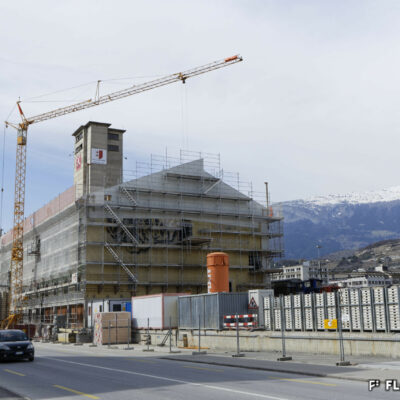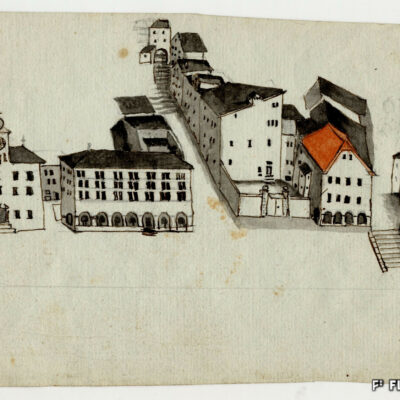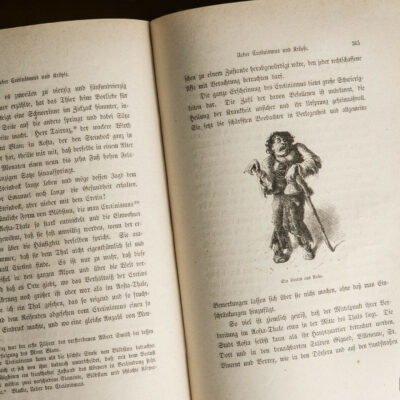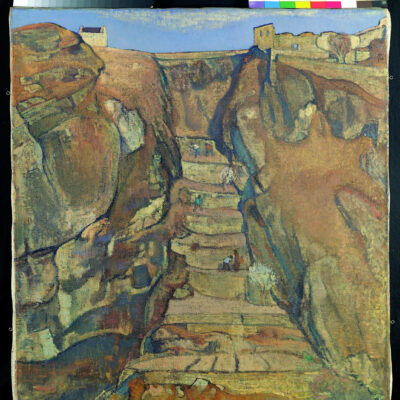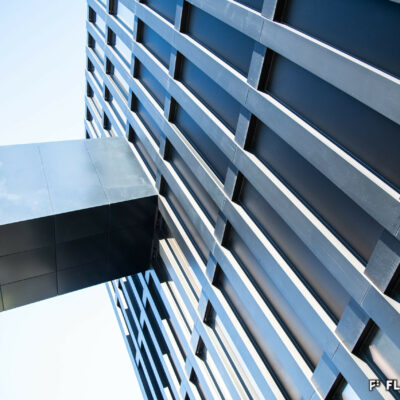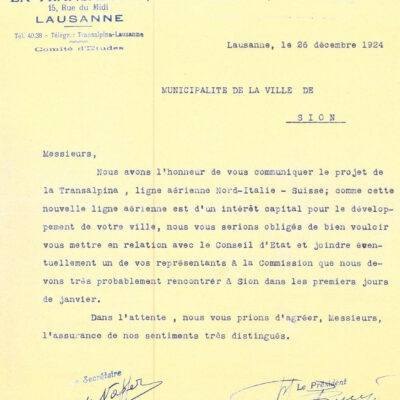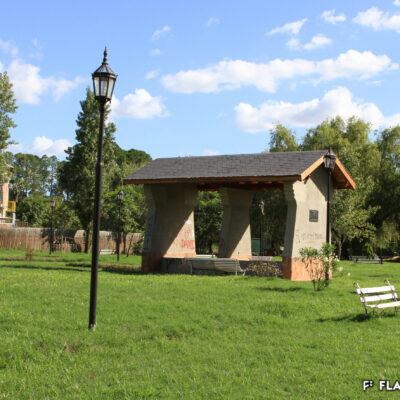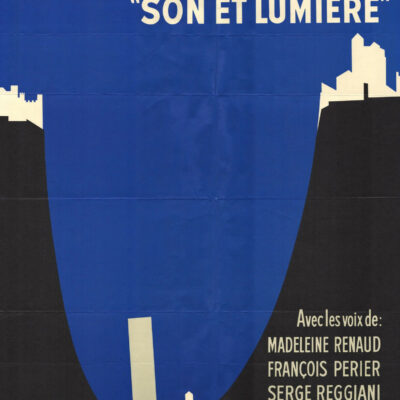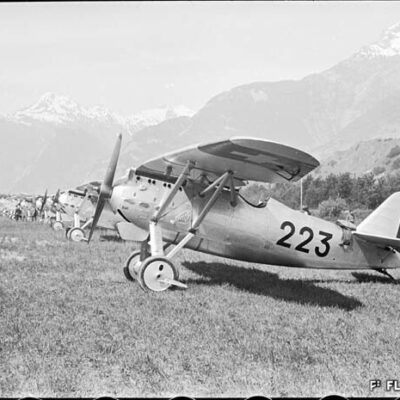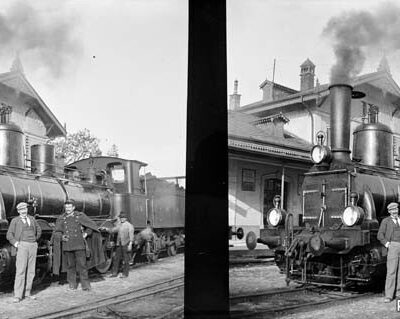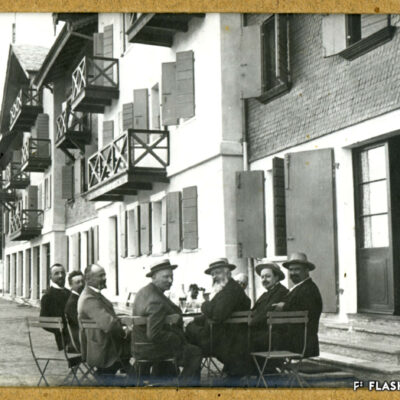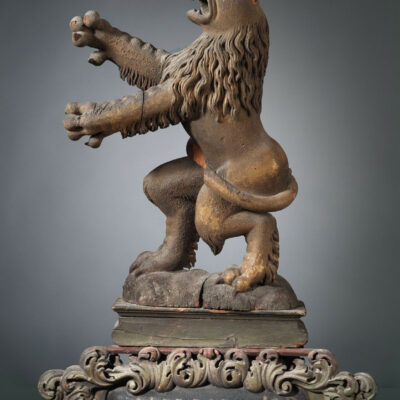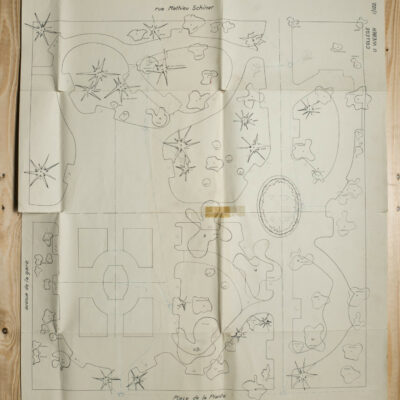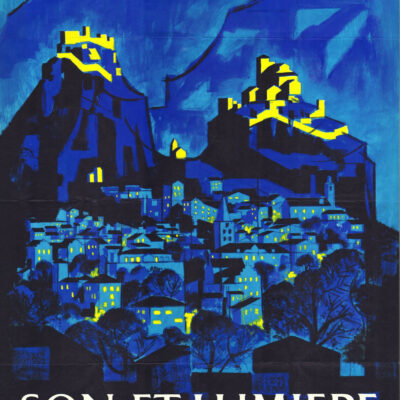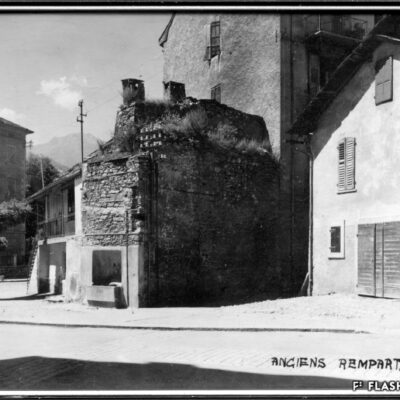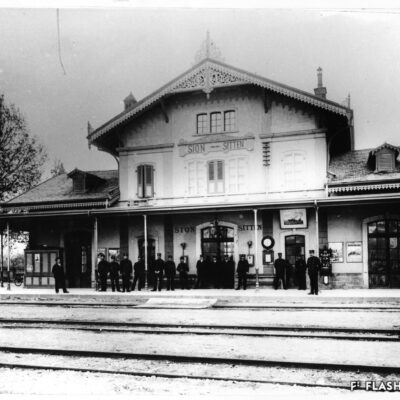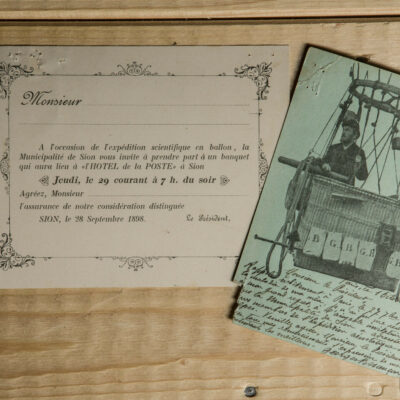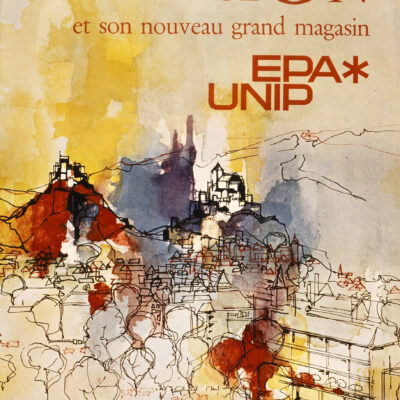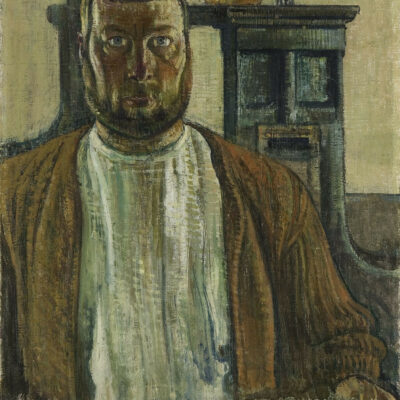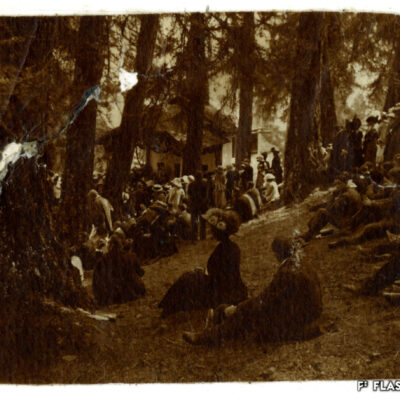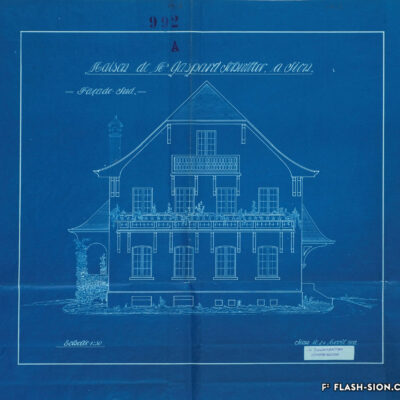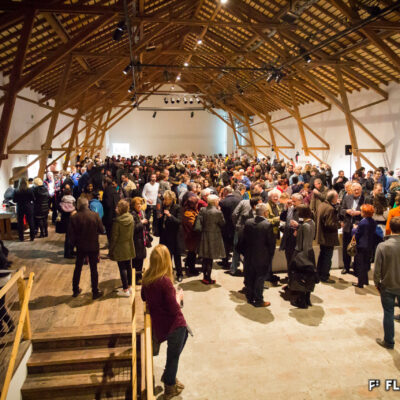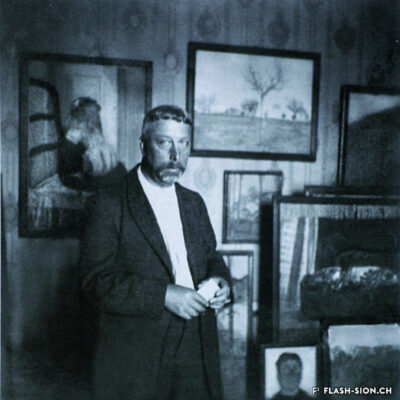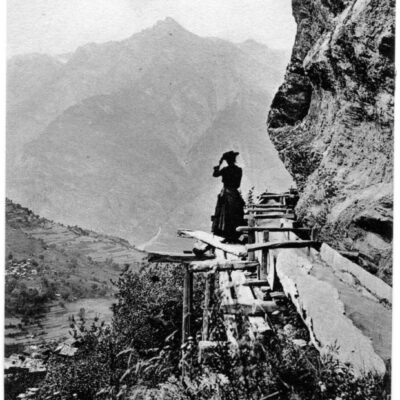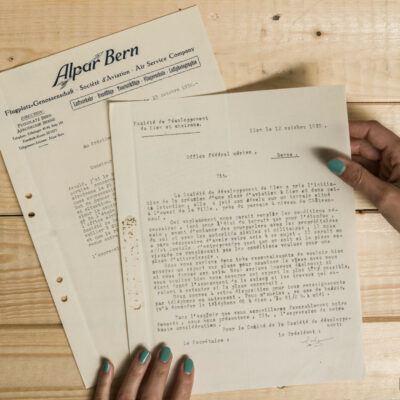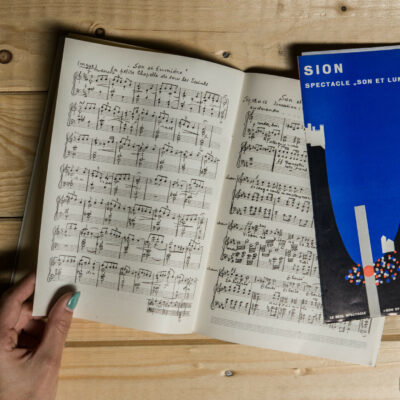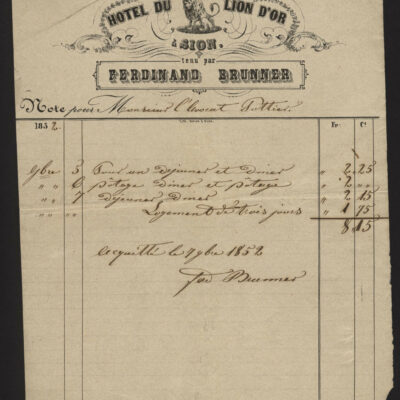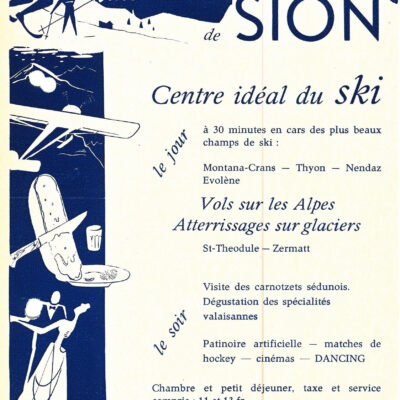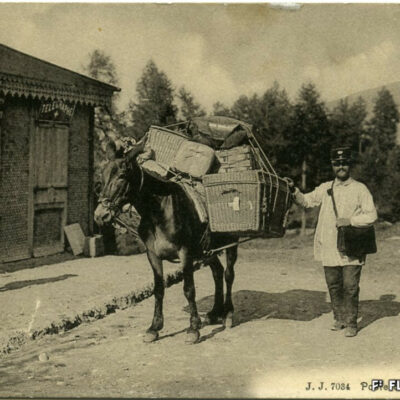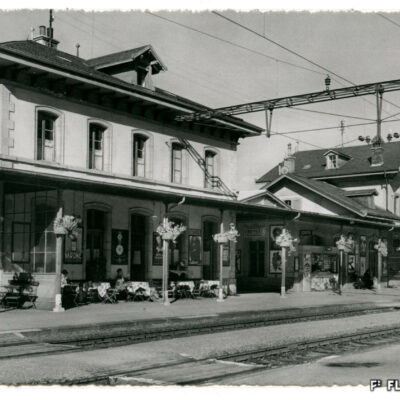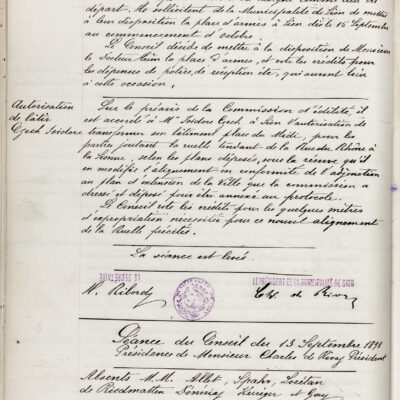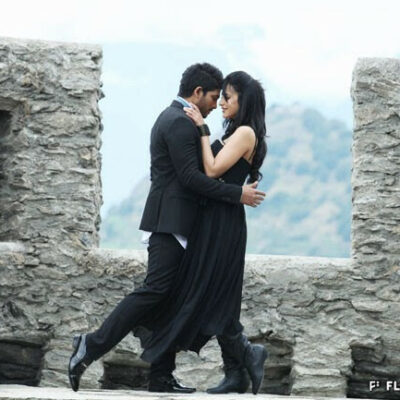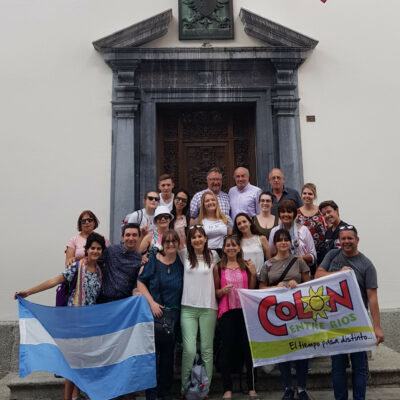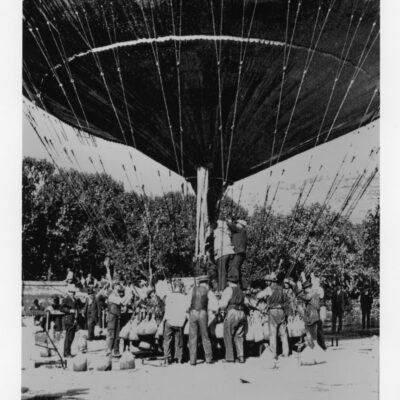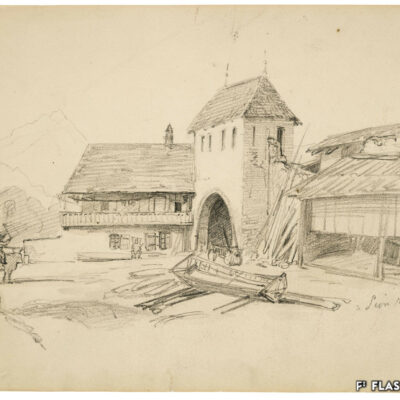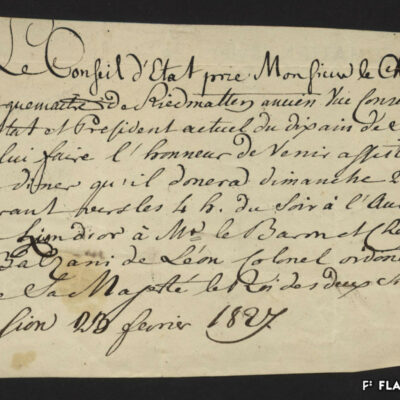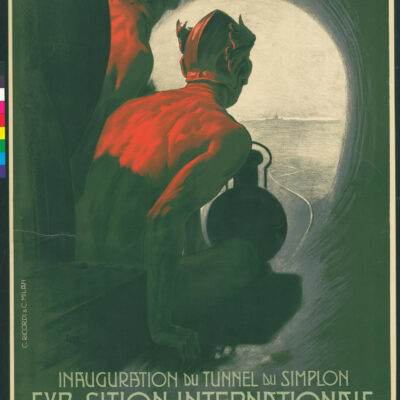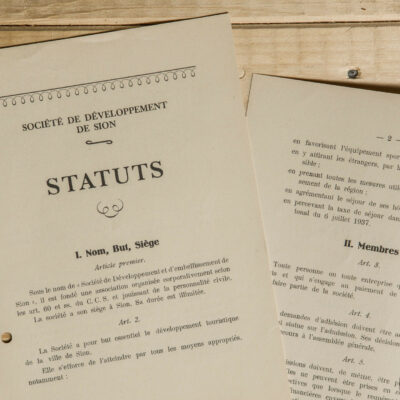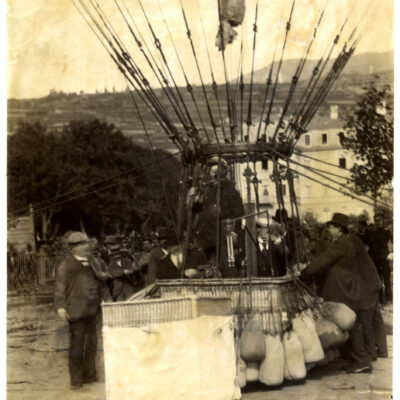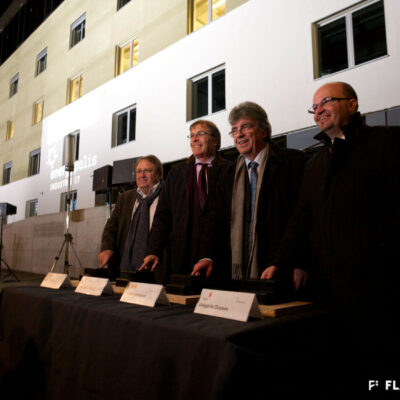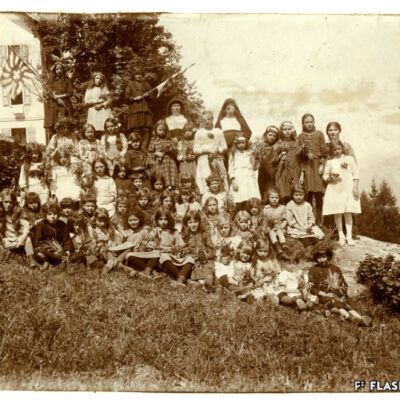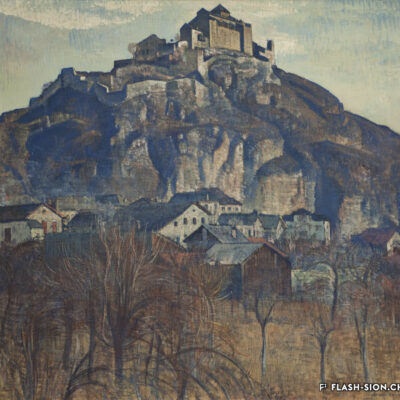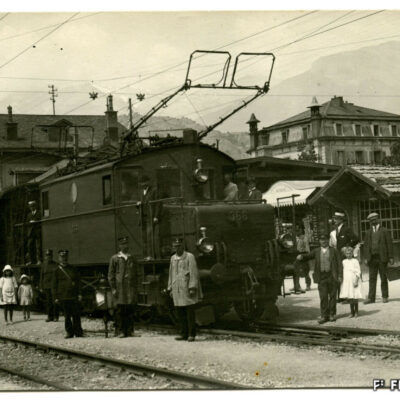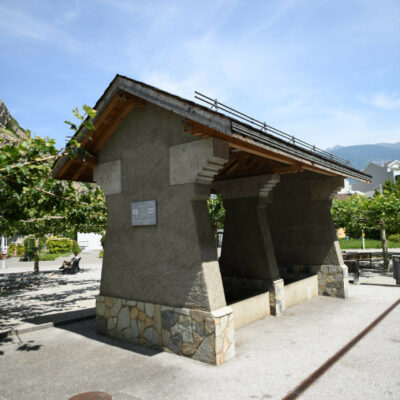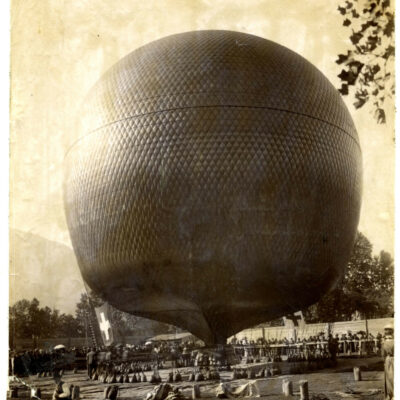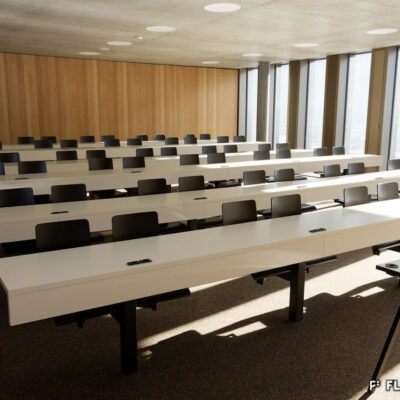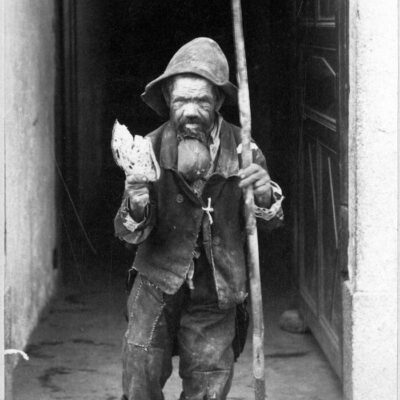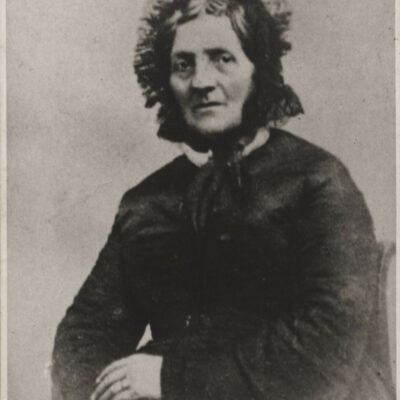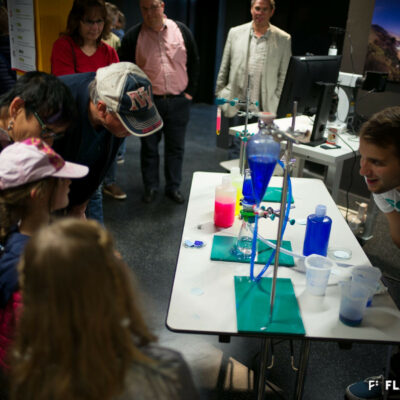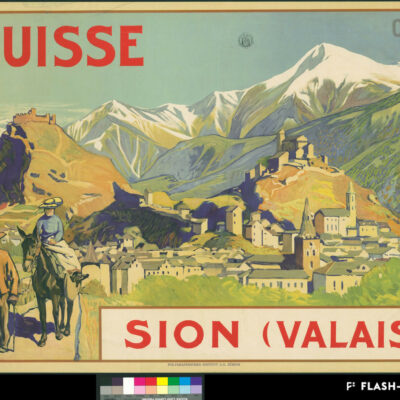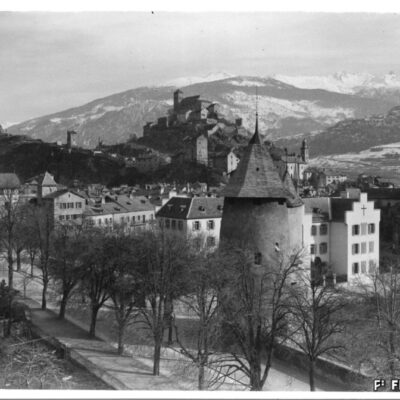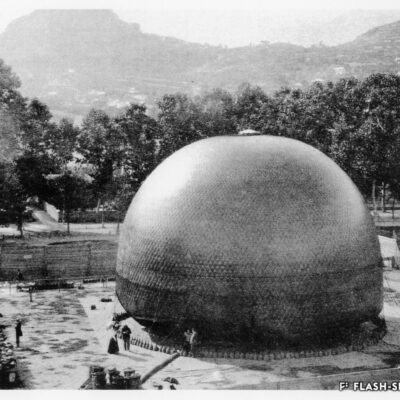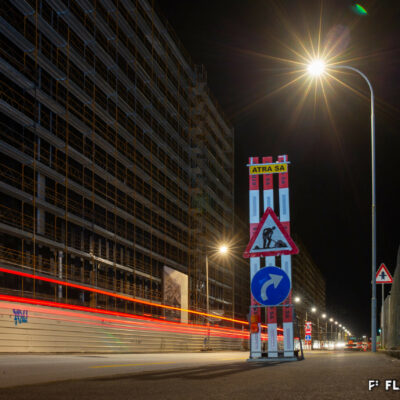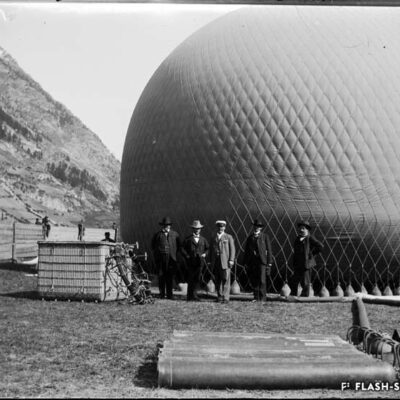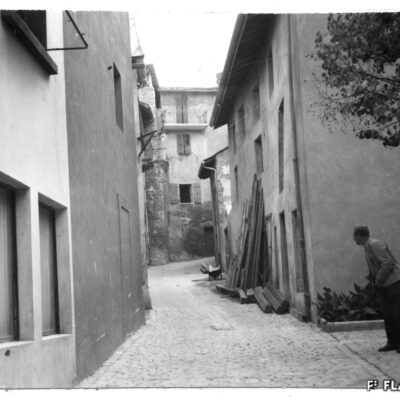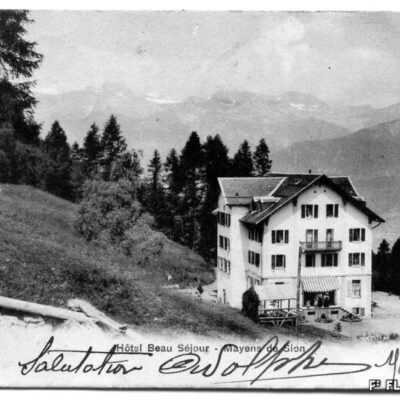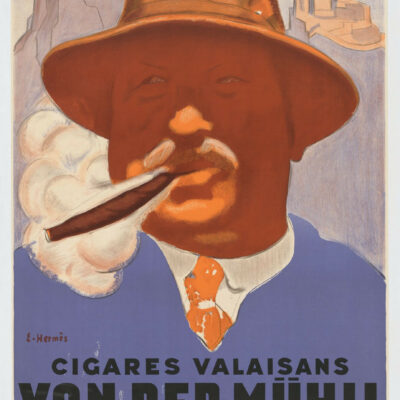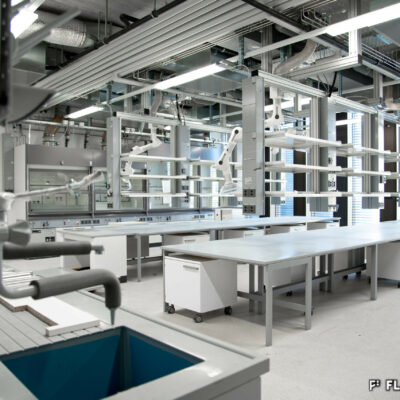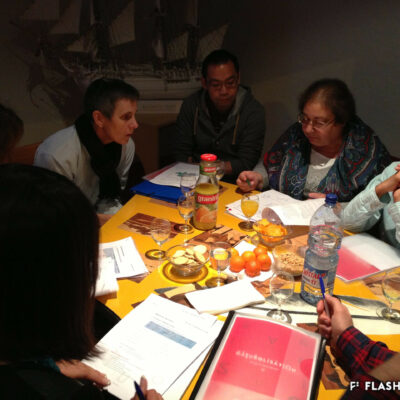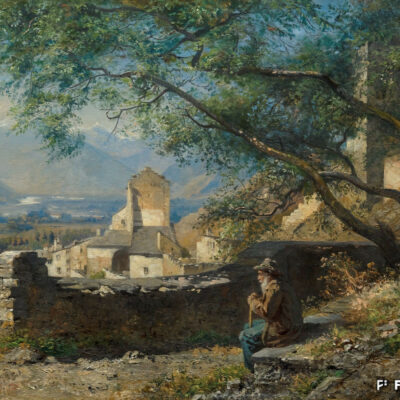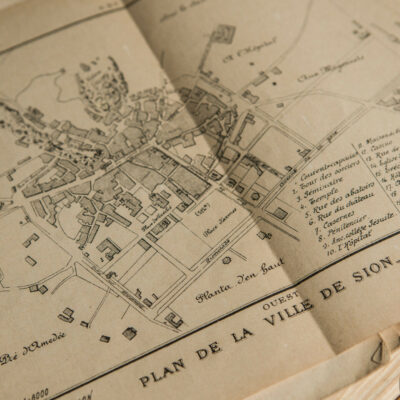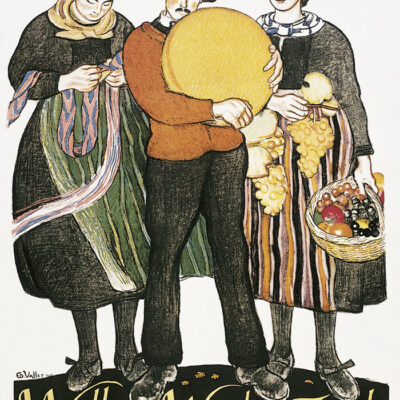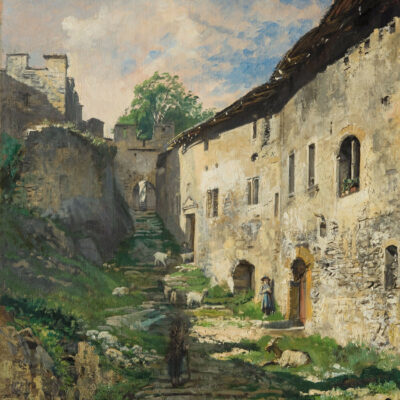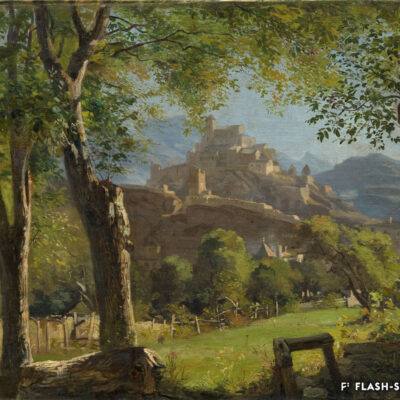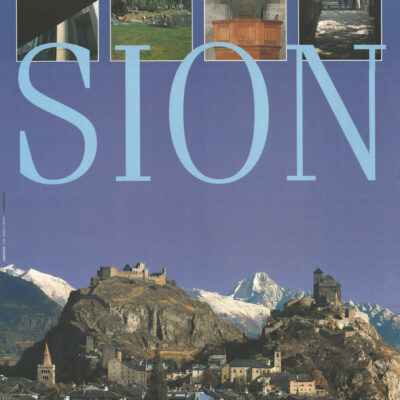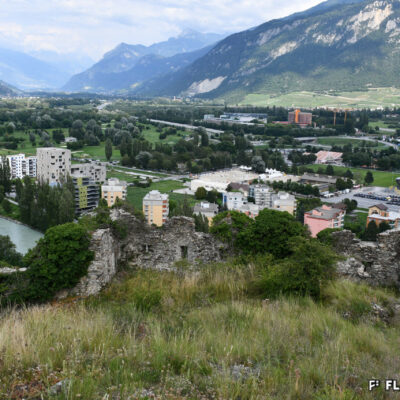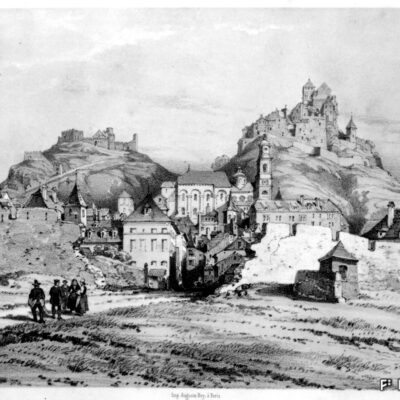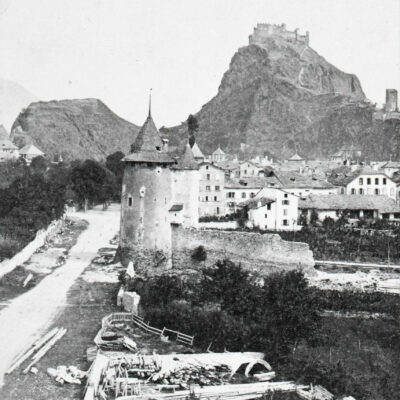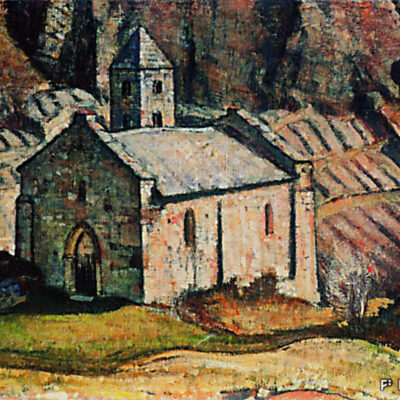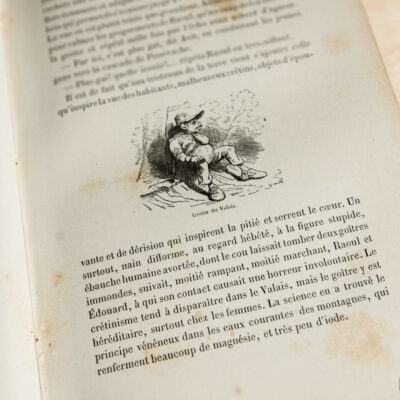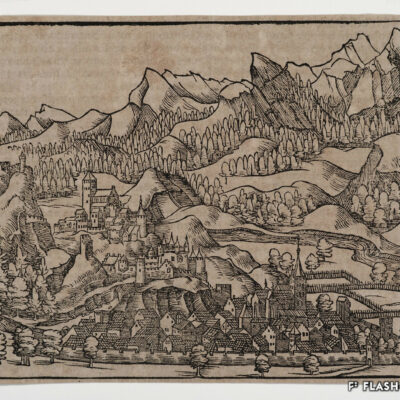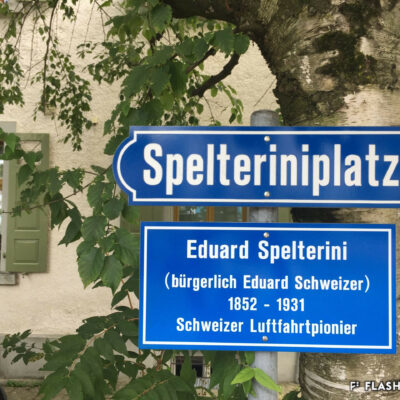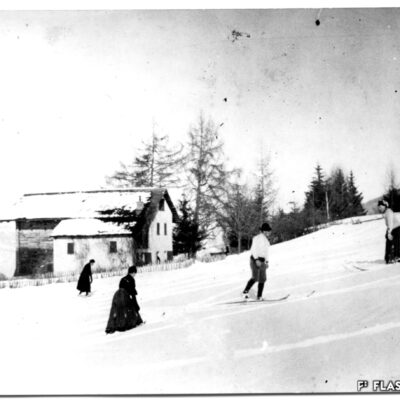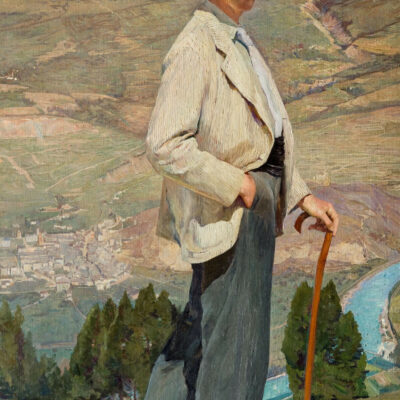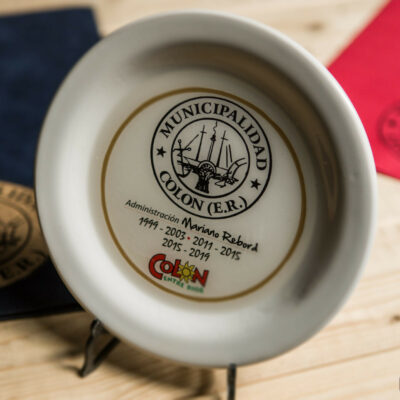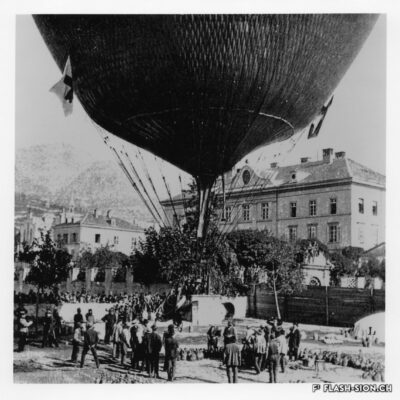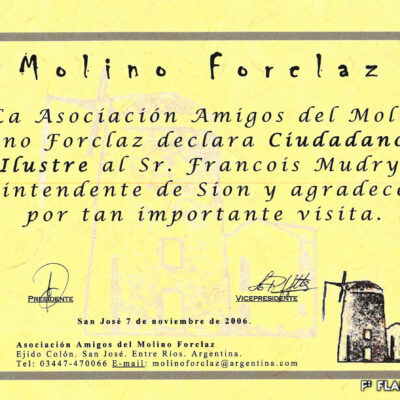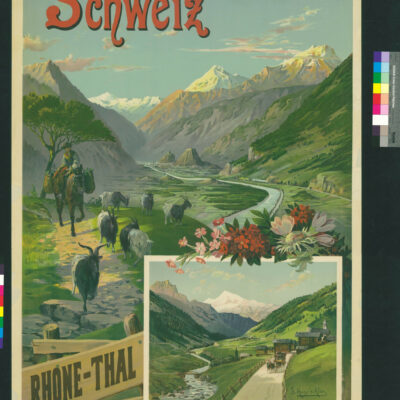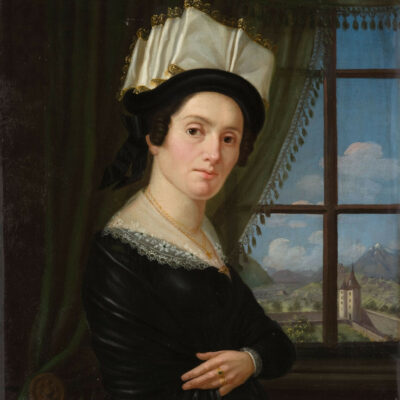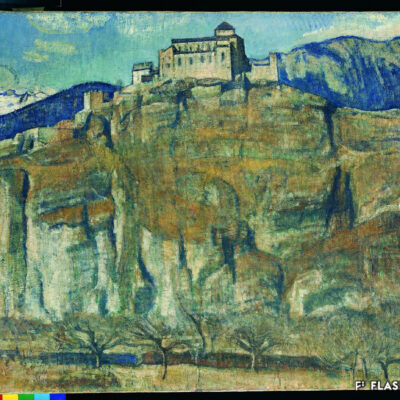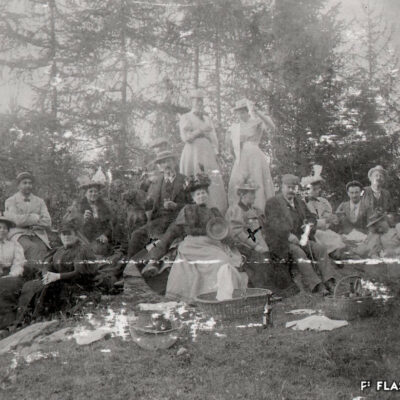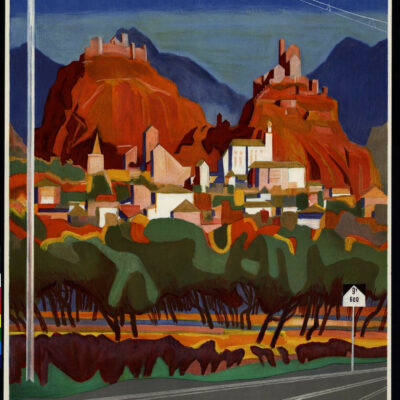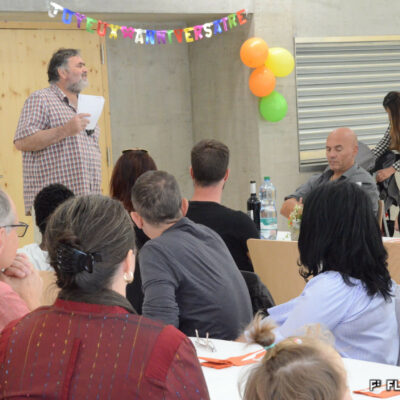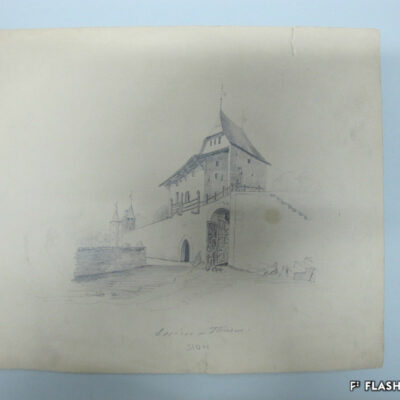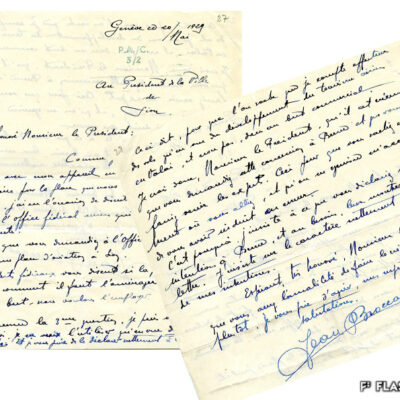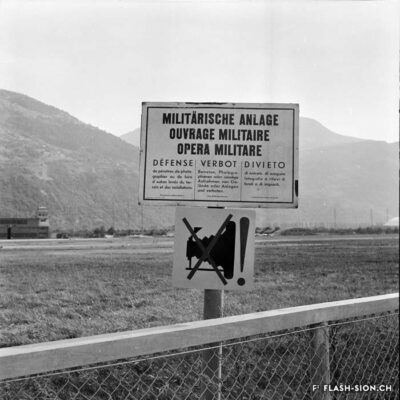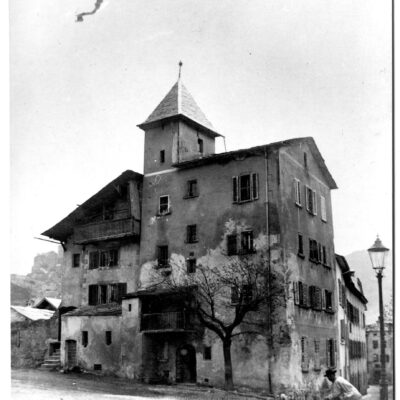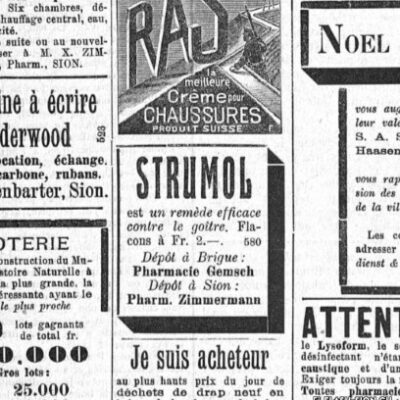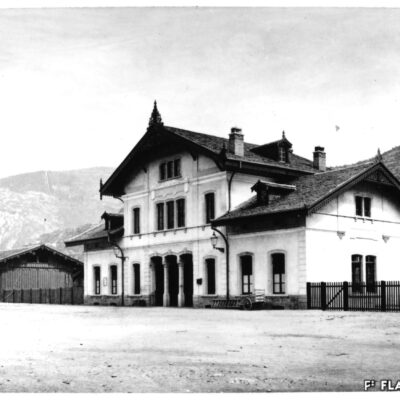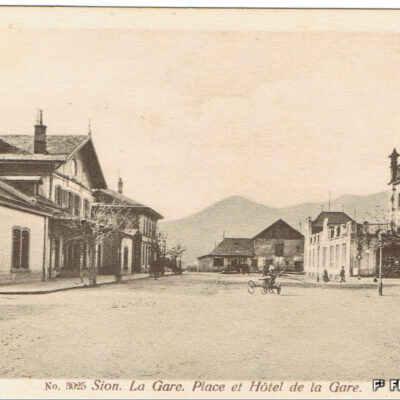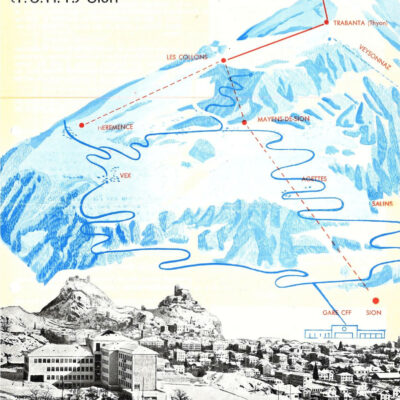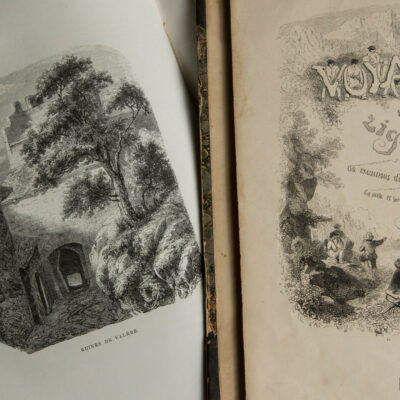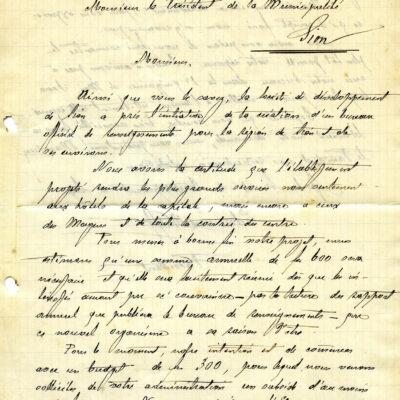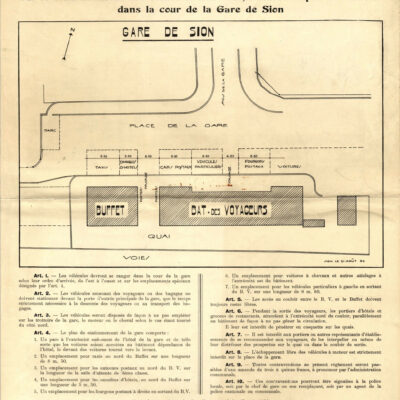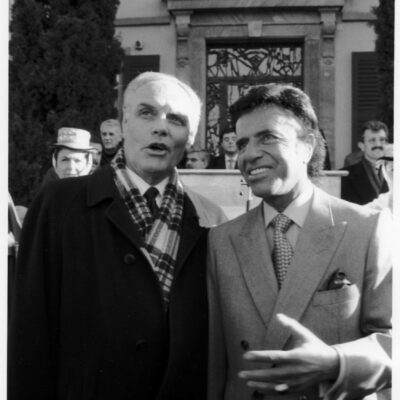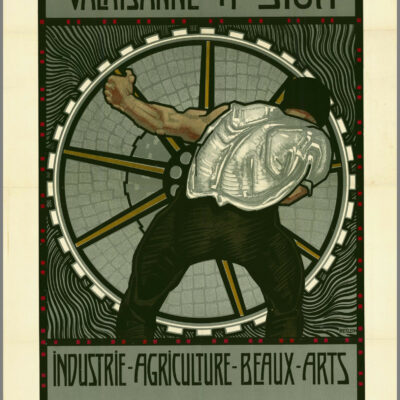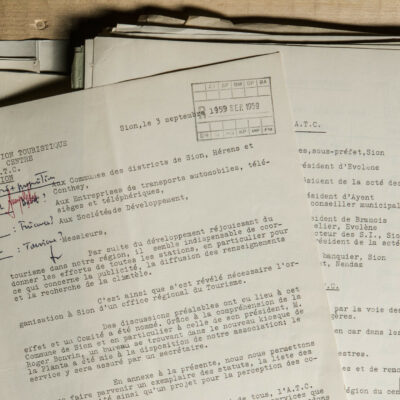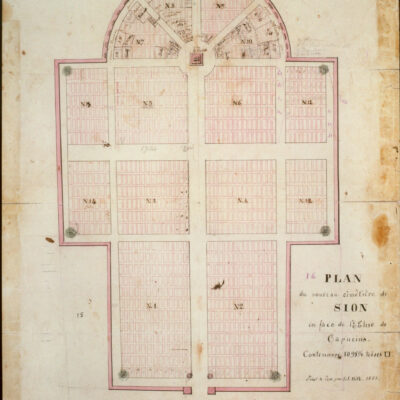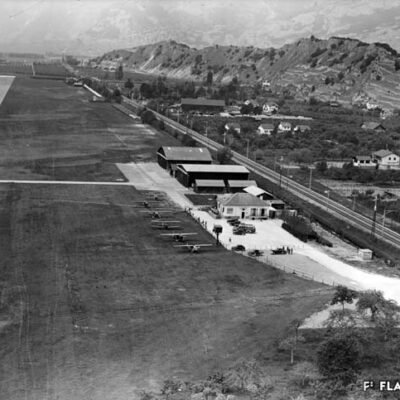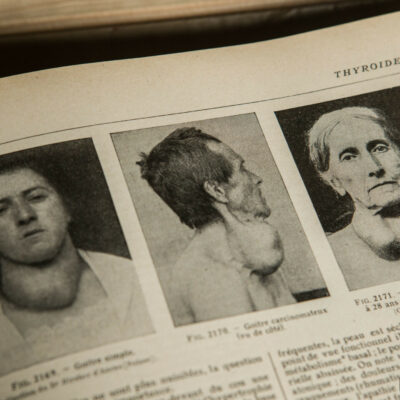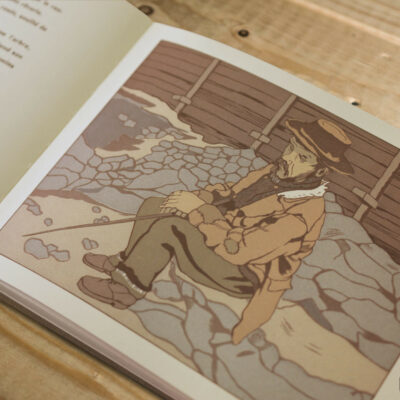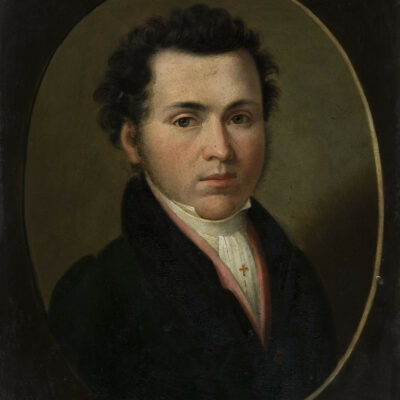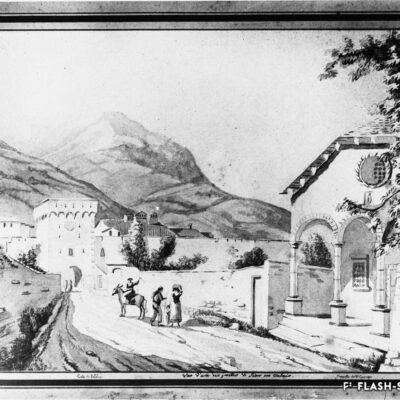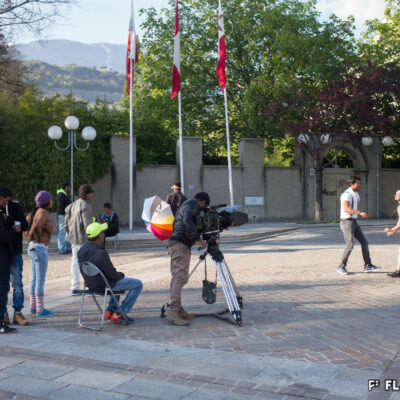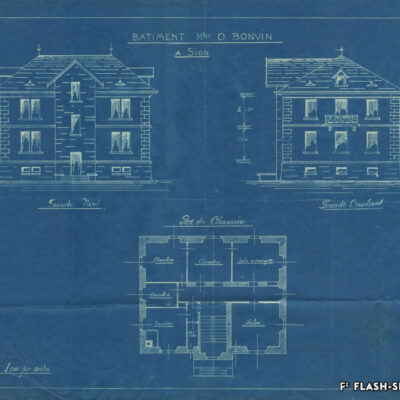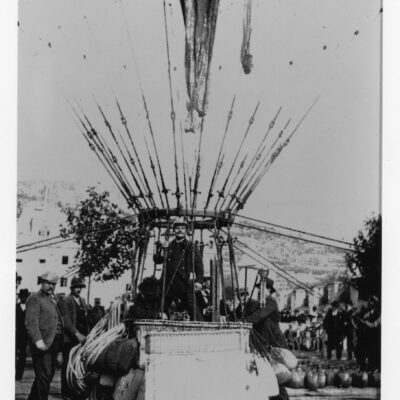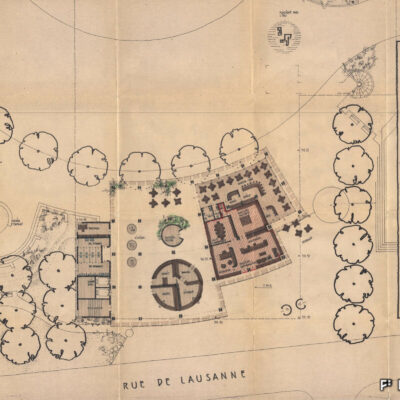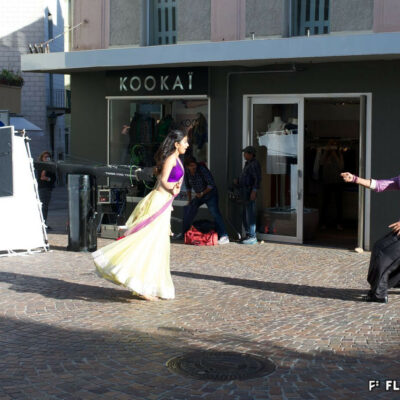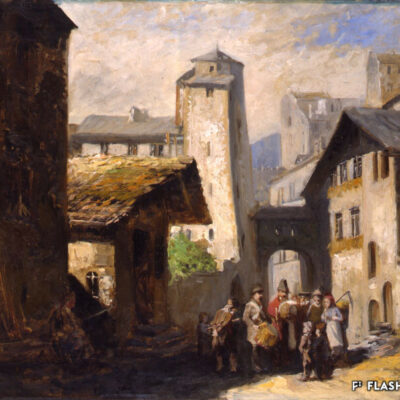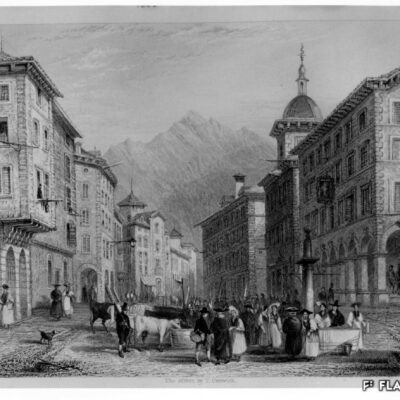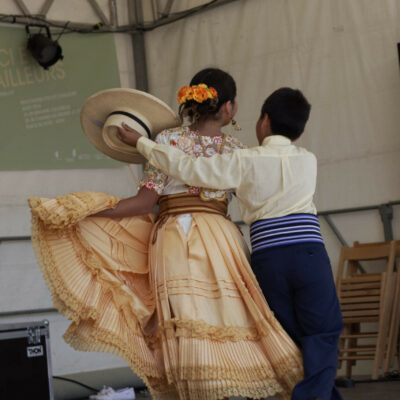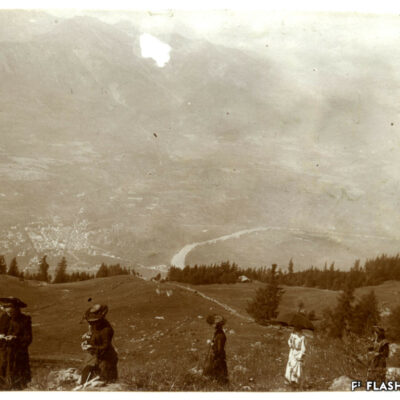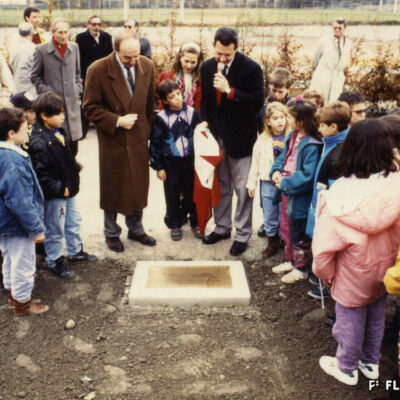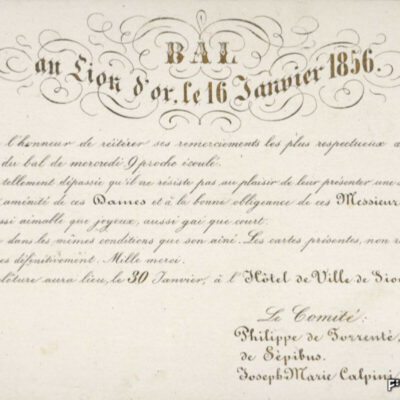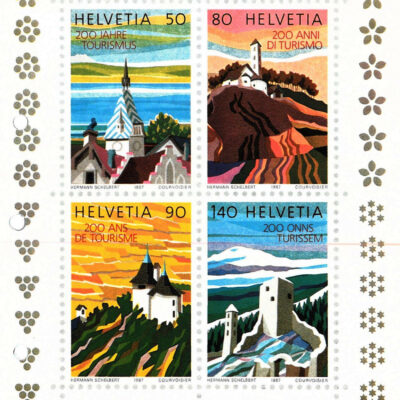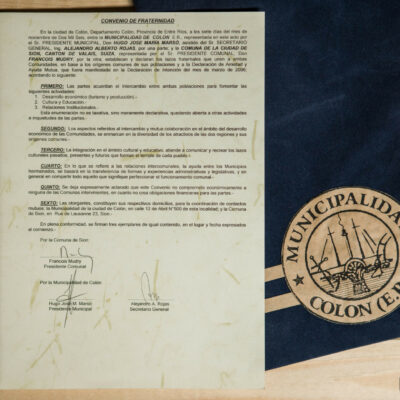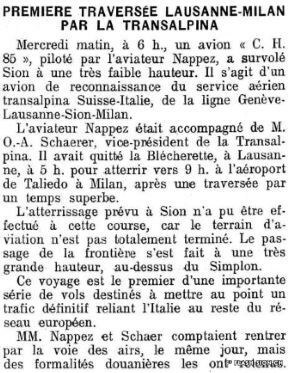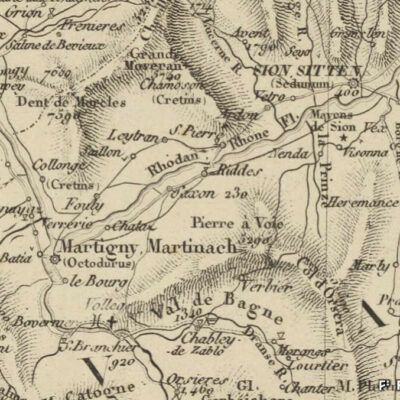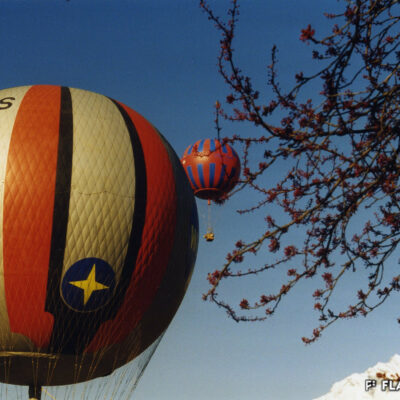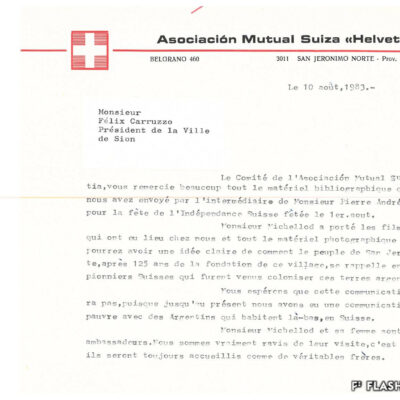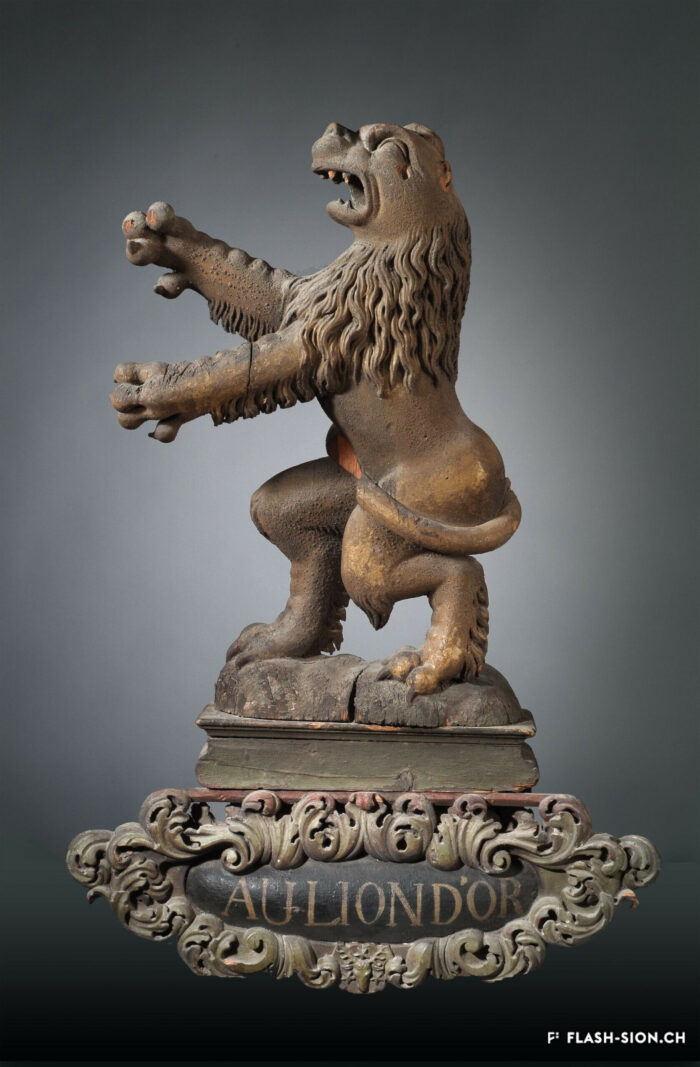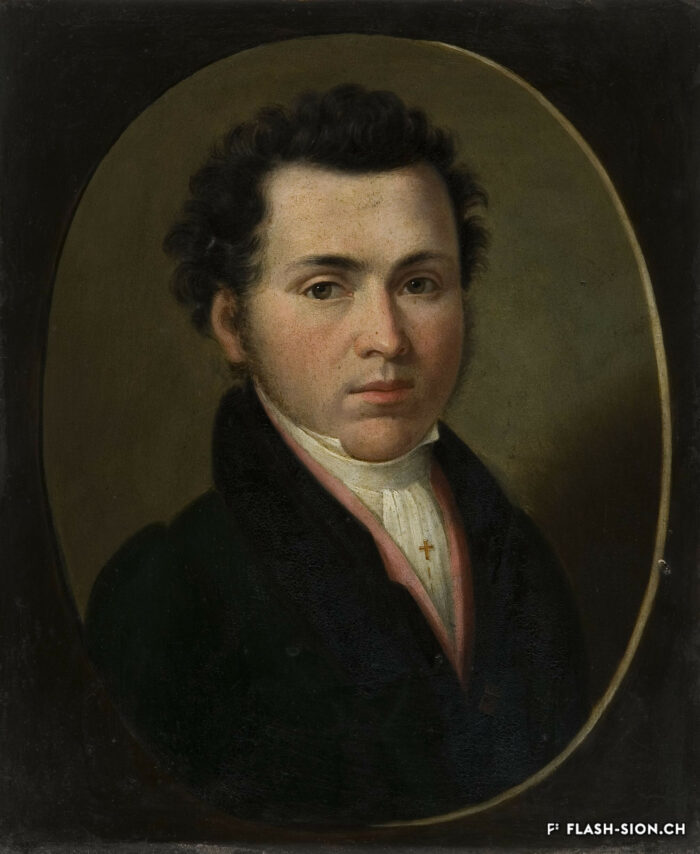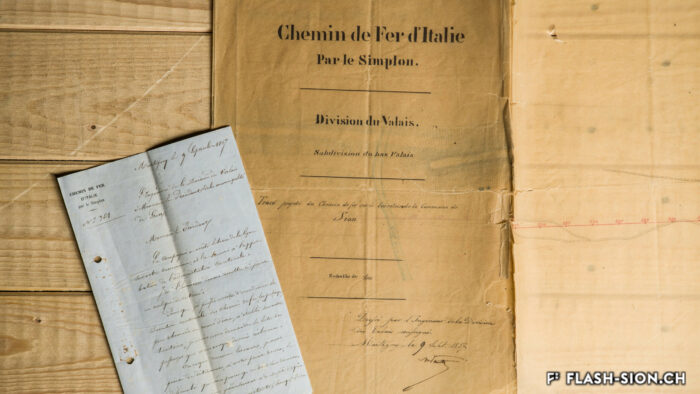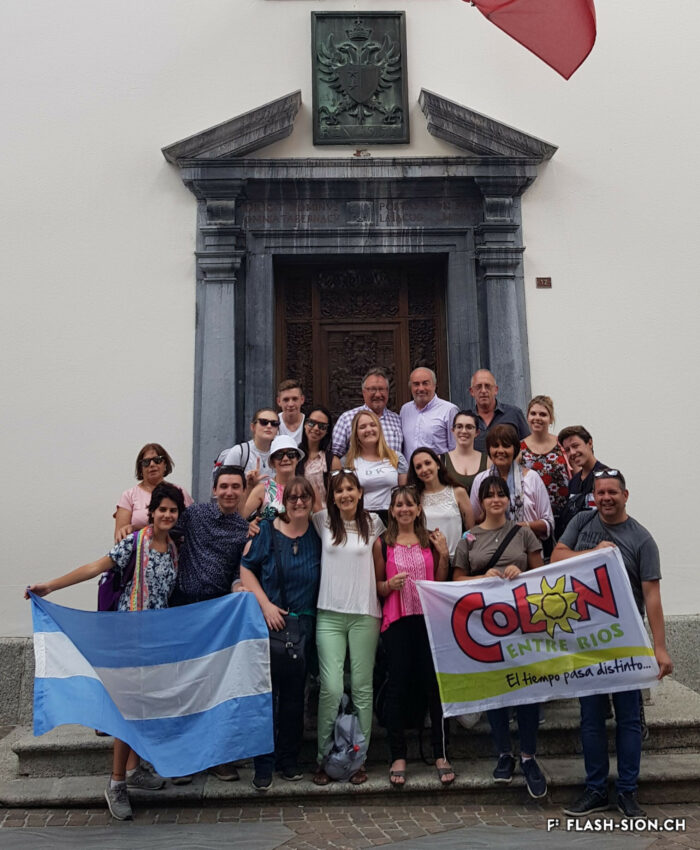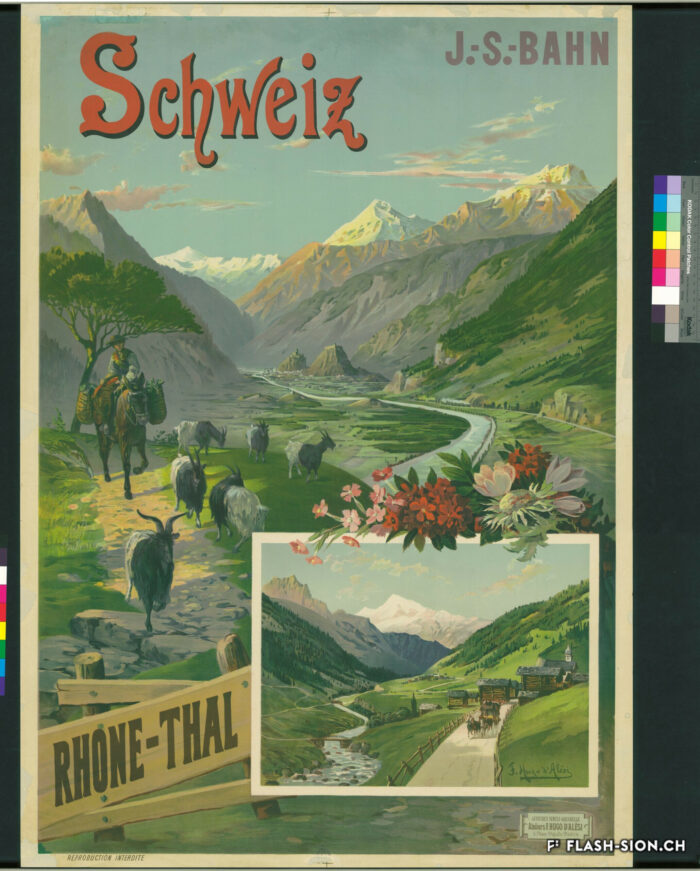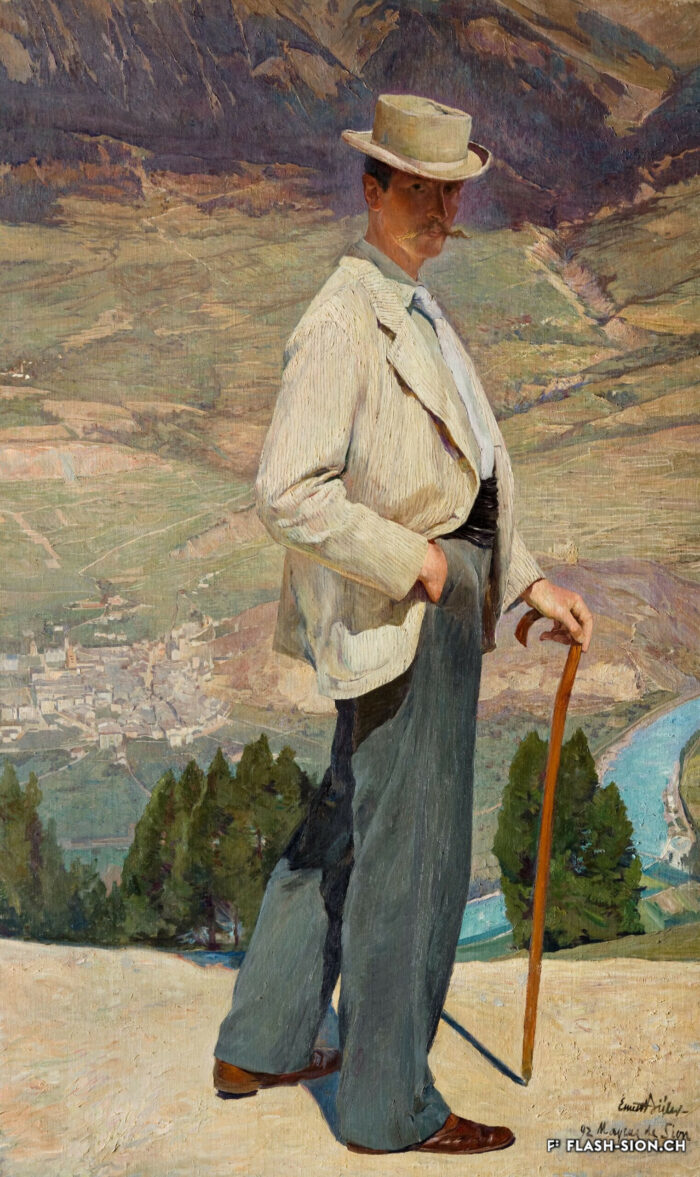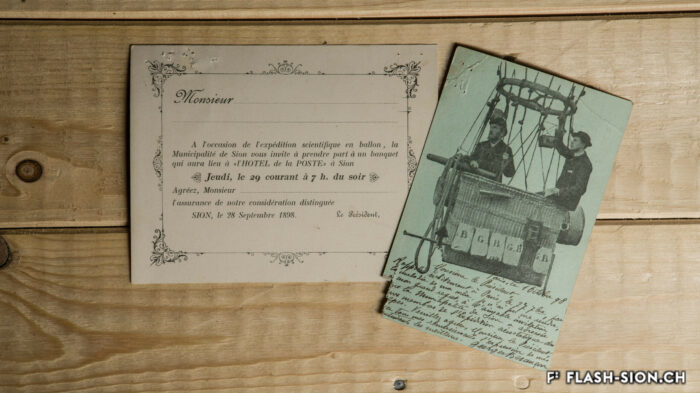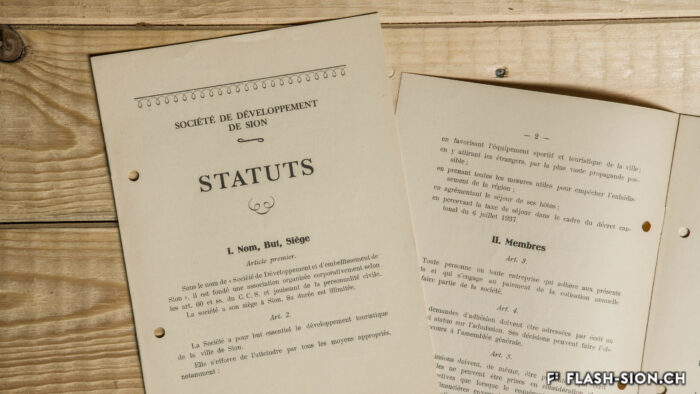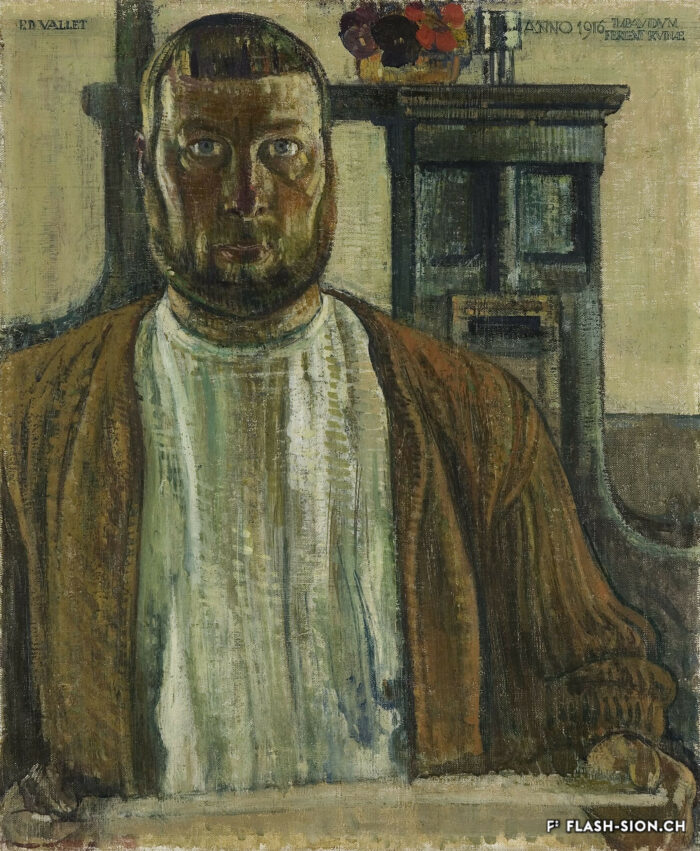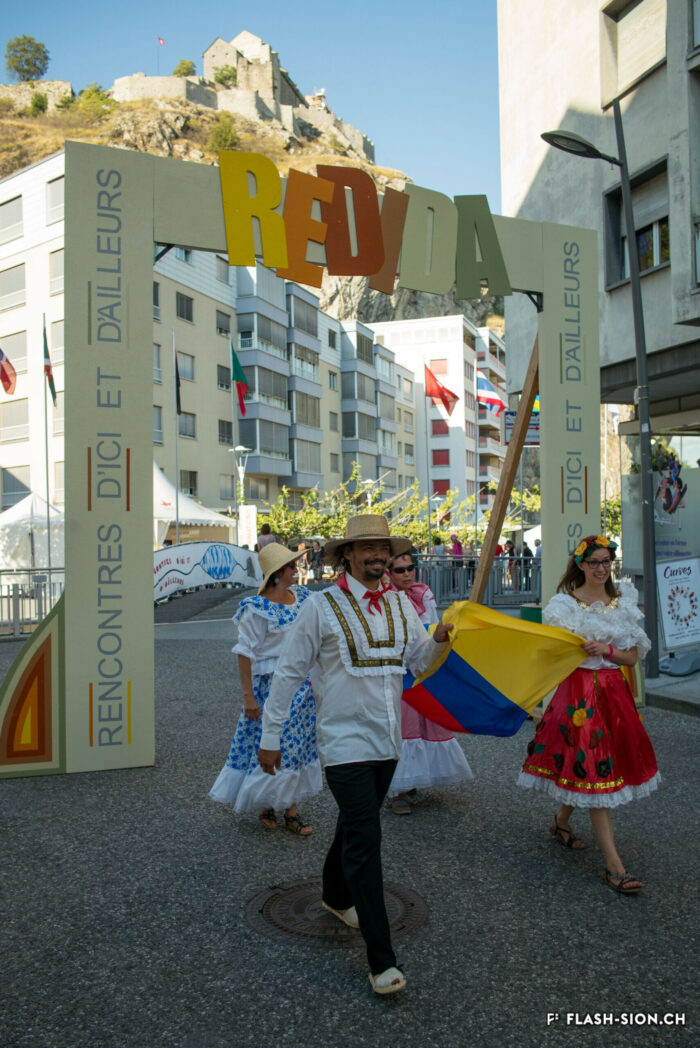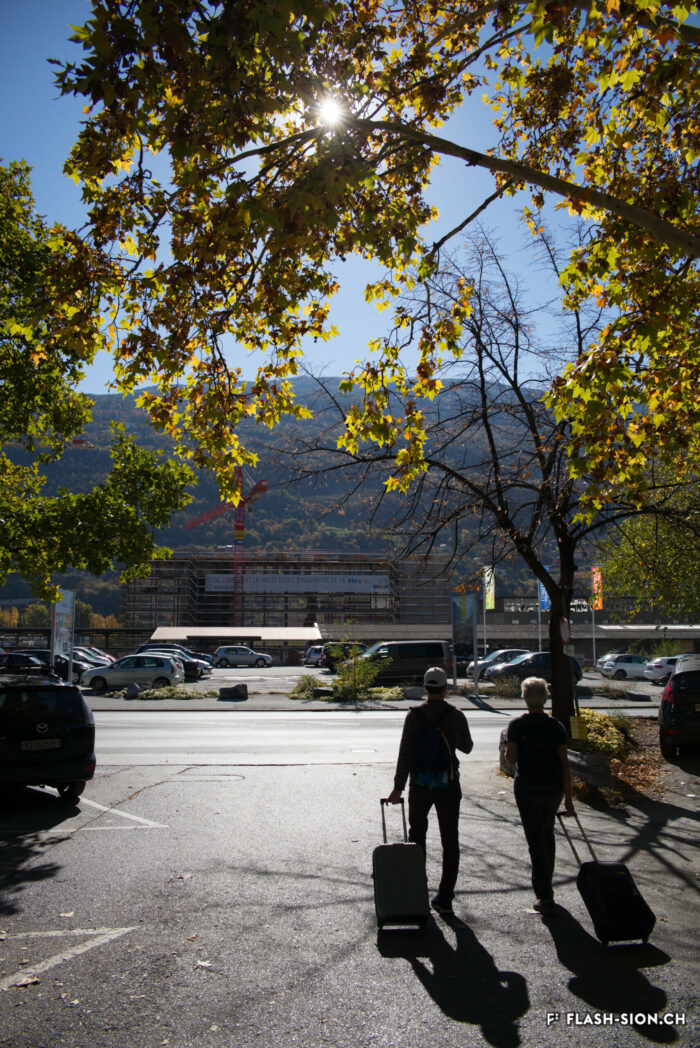Aux portes de Sion
Dès le Haut Moyen Age, la présence d’enceintes fortifiées est attestée pour la cité sédunoise. Elles retracent le développement de la ville jusqu’au tournant du 15e siècle. La dernière et plus grande enceinte, démantelée dans la première moitié du 19e siècle, comportait 7 portes. Ces passages obligés et bien gardés symbolisent autant l’échappée et l’ouverture sur le monde que la fermeture et le repli en cas de guerre avec la canalisation et le contrôle des gens et des marchandises et la perception de taxes et de péages. Les vestiges de la porte de Covent, située entre les collines de Valère et Tourbillon, constituent un dernier témoin d’un accès à la cité médiévale.
Vor den Toren von Sitten
Vom Frühmittelalter bis ins 15. Jahrhundert lässt sich die Entwicklung der Stadt Sitten anhand des Verlaufs der Befestigungsmauern ablesen. Die letzte und grösste Ringmauer, deren Schleifung in der ersten Hälfte des 19. Jahrhunderts stattfindet, zählte 7 befestigte Tore. Diese streng bewachten Zugänge versinnbildlichen sowohl die Öffnung zur Aussenwelt als auch den Rückzug und die Abriegelung im Kriegsfalle mit Regulierung und Kontrolle der Stadtbesucher und des Warenaustausches sowie der Erhebung von Zöllen und Abgaben. Die Reste des Covent-Tors zwischen den Burghügeln von Valeria und Tourbillon sind ein letzter Zeuge eines Zugangs zur mittelalterlichen Stadt.
At the gates of Sion
Records of the presence of fortification walls have been documented in the City of Sion since the Early Middle Ages. These walls reflected the city’s development till the turn of the 15th century. The last and largest fortification wall, dismantled during the first half of the 19th century, included 7 fortified gateways. These obligatory and well-guarded passages were symbols of both escape and openness to the world as well as closure and withdrawal in the event of war. The flow of people and goods was channelled and controlled through them, while taxes and tolls were collected. The remains of the Covent Gate, situated between the hills of Valère and Tourbillon, are the last witness of an access to the medieval city.
Alle porte di Sion
A partire dall’alto Medioevo è attestata la presenza di una cinta fortificata attorno alla città di Sion. Queste mura tracciano lo sviluppo della città fino alla fine del 15esimo secolo. La più grande e ultima cinta muraria smantellata nella prima metà del 19esimo secolo aveva 7 porte. Questi passaggi obbligati e ben sorvegliati simbolizzano sia la fuga e l’apertura al mondo che la chiusura e il ritiro in caso di guerra, permettendo di convogliare e controllare le persone e le merci, e di riscuotere tasse e pedaggi. Le vestigia della Porte de Covent, situata fra le colline di Valère et Tourbillon, costituiscono un’ultima testimonianza di un accesso alla città medievale.
Misérable ! Analphabète ! Crétin des Alpes !
« Une ville noire et laide, peuplée de crétins aux goitres pendants », semble s’offrir aux voyageurs de passage à Sion au 18e siècle. Le dictionnaire raisonné d’Alembert définit les crétins comme « une espèce d’hommes que l’on retrouve en grand nombre en Valais et surtout à Sion ». Les pharmacies sédunoises proposent ainsi différents remèdes contre l’augmentation difforme du volume de la glande thyroïde. Mais il faut attendre l’introduction du sel iodé en Valais en 1924 pour voir disparaître ce fléau. Le cliché « Crétins des Alpes » par contre, célèbre insulte du capitaine Haddock également, reste ancré dans les esprits jusqu’à nos jours.
Elender ! Analphabet ! Kretin !
„Eine düstere, hässliche und von Schwachsinnigen mit herabhängendem Kropf besiedelte Stadt“ scheint sich den Reisenden im 18. Jahrhundert in Sion geboten zu haben. Die wissenschaftliche Enzyklopädie Alemberts definiert die Kretinen als „eine Menschenart, die im Wallis und insbesondere in Sitten gehäuft vorkommt“. Die Sittener Apotheken bieten daher unterschiedliche Wundermittel gegen die monströse Zunahme des Schilddrüsenvolumens feil. Erst mit der Einführung von Jodsalz im Wallis im Jahr 1924 konnte man der Krankheit allmählich Herr werden. Das Klischee des „Crétins des Alpes“ hingegen, das durch die Fluchtiraden des Kapitän Haddock bekannt geworden ist, bleibt bis heute in den Köpfen der Menschen verankert.
An idiot of the Alpes! Miserable and illiterate!
Travellers passing though Sion in the 18th century seemed to view the city as « black and ugly, full of idiots with dangling goitres». Alembert’s Reasoned Dictionary gave a definition of idiots as « a sort of man found in large numbers in Valais and especially in Sion ». Sion’s pharmacies provided various remedies for the growing volume of thyroid gland. But it was only after iodized salt had been introduced in Valais in 1924 that the problem was eradicated. However, the cliché of « Idiots of the Alps », which was also a famous Captain Haddock’s insult, has remained engrained in people’s minds to the present day.
Miserabile! Analfabeta! Cretino delle Alpi!
« Una città nera e brutta, popolata da cretini e persone con i gozzi pendenti », sembra essere ciò che veniva offerto ai viaggiatori di passaggio a Sion nel 18esimo secolo. Il dizionario ragionato di d’Alembert definisce i cretini come « una specie di uomini che si trovano in gran numero in Vallese e soprattutto a Sion». Le farmacie di Sion proponevano vari rimedi contro l’aumento sproporzionato del volume della ghiandola tiroide. Ma fu solo con l’introduzione del sale iodato nel 1924 che questo flagello scomparve. Il cliché « Cretini delle Alpi » invece, celebre insulto del capitano Haddock, resta tutt’oggi ancorato nella mente della gente.
Une chambre, aubergiste !
En quête de romantisme alpin, les premiers touristes apparaissent en Valais dans la seconde moitié du 18e siècle. Les voyageurs de passage pour la nuit font halte chez l’aubergiste. Le plus souvent familiale, l’auberge accueille tant les nobles que les voyageurs ou commerçants. L’auberge du Lion d’Or était l’un des plus anciens établissements de la capitale. Des célébrités telles que Jean-Jacques Rousseau (1744), Johann Wolfgang von Goethe (1779) ou encore l’impératrice Joséphine (1812) y prirent une chambre lors de leur séjour à Sion. Dès le milieu du 19e siècle, les auberges cèdent progressivement la place aux hôtels qui se professionnalisent. Peu à peu, les guides de voyage aident les touristes dans leurs déplacements, proposent des itinéraires et fournissent les informations pratiques.
Ein Zimmer bitte!
Auf der Suche nach der viel besungenen Alpenromantik kommen in der zweiten Hälfte des 18. Jahrhunderts die ersten Touristen ins Wallis. Die Reisenden finden über Nacht in Gasthöfen Unterkunft. In diesen meist von Familien geführten Gasthäusern steigen Adlige genauso ab wie einfache Reisende oder Händler. Das Gasthaus Lion d’Or gehört zu den ältesten Unterkünften der Hauptstadt. Berühmte Persönlichkeiten wie Jean-Jacques Rousseau (1744), Johann Wolfgang von Goethe (1779) oder auch die Kaiserin Joséphine (1812) haben hier übernachtet. Ab Mitte des 19. Jahrhunderts werden die Gasthöfe allmählich von Hotels abgelöst, die sich über eine professionelle Führung auszeichnen. Nach und nach helfen Reiseführer den Touristen, ihre Reisen zu organisieren, schlagen Routen vor und geben weitere praktische Informationen.
Innkeeper, a room please!
The first tourists looking for mountain romance appeared in Valais in the second half of the 18th century. Passing travellers looking for an overnight stay made a stop at one of the inns. Those mostly family-run inns welcomed noblemen as well as travellers or merchants. The Lion d’Or Inn was one of the oldest establishments in the capital city. Celebrities such as Jean-Jacques Rousseau (1744), Johann Wolfgang von Goethe (1779) or the Empress Joséphine (1812) took up a room there during their stay in Sion. From the mid-19th century, inns gradually gave way to hotels, which became more professional. Little by little tourist guides started helping tourists with their travels, offering excursions and providing practical information.
Una camera, locandiere !
Alla ricerca di romanticismo alpino, i primi turisti appaiono in Vallese nella seconda metà del 18esimo secolo. Nella locanda si fermano i viaggiatori di passaggio per la notte. Spesso a conduzione famigliare accoglie sia nobili che viaggiatori o commercianti. L’auberge du Lion d’or era una dei più vecchi stabili della capitale. Celebrità come Jean-Jacques Rousseau (1744), Goethe (1779) o ancora l’imperatrice Joséphine (1812) presero una camera qui durante il loro soggiorno a Sion. Dalla metà del 19esimo secolo, le locande cedono progressivamente il posto agli Hotel che diventano più professionali. Poco a poco le guide di viaggio aiutano i turisti nei loro spostamenti, proponendo itinerari e fornendo loro informazioni pratiche.
Les Ritz, peintres de père en fils
Lorenz Justin Ritz (1796-1870), originaire de Niederwald dans la vallée de Conches, s’installe à Sion en 1839. Peintre religieux et portraitiste incontournable de l’époque, il est l’auteur d’environ 650 portraits. En 1842, il épouse en secondes noces une Sédunoise, Marguerite de Torrenté. Conseiller municipal de Sion de 1848 à 1860, il s’implique au sein de la commune nouvellement créée. Lorenz Justin Ritz est également le père de Raphaël Ritz (1829-1894), peintre de renom. Suivant l’enseignement paternel, Raphaël va devenir l’un des artistes valaisans les plus importants du 19e siècle. L’ancienne avenue du Nord porte aujourd’hui leur nom et leur rend hommage.
Vater und Sohn die Maler Lorenz Justin und Raphael Ritz
Der aus Niederwald im Goms stammende Lorenz Justin Ritz (1796-1870) lässt sich 1839 in Sitten nieder. Als wichtiger Porträt- und Kirchenmaler seiner Zeit hat er an die 650 Porträts geschaffen. 1842 heiratet er in zweiter Ehe Marguerite de Torrenté aus Sitten. Zwischen 1848 und 1860 engagiert er sich als Gemeinderat für die neugegründete politische Gemeinde. Eines seiner Kinder ist der ebenfalls renommierte Genremaler Raphael Ritz (1829-1894). Der väterlichen Lehre folgend wird dieser zu einem der bedeutendsten Walliser Maler des 19. Jahrhunderts. Die frühere Avenue du Nord trägt heute den Namen der Maler und würdigt Vater und Sohn gleichermassen.
The Ritz, family of painters from father to son
Lorenz Justin Ritz (1796-1870), a native of Niederwald in the Goms Valley, settled In Sion in 1839. A major religious and portrait painter of his time, he was an author of about 650 portraits. In 1842, he married his second wife, Marguerite de Torrenté of Sion. He was a municipal councillor of Sion between 1848 and 1860 and played an active role in the newly created municipality. Lorenz Justin Ritz was also the father of Raphaël Ritz (1829-1894), a renowned painter. Following his father’s education, Raphaël became one of the most important artists of the 19th century of Valais. The former North Avenue was renamed after the artists as a tribute to both of them.
I Ritz, pittori di padre in figlio
Lorenz Justin Ritz (1796-1870), originario di Niederwald nella valle di Conches s’installò a Sion nel 1839. Pittore religioso e ritrattista dell’epoca è stato l’autore di circa 650 ritratti. Nel 1842 sposò in seconde nozze Marguerite de Torrenté, originaria di Sion. Venne eletto consigliere municipale di Sion dal 1848 al 1860 e s’impegna politicamente nel comune creato da poco. Lorenz Justin Ritz è stato anche padre di Raphaël Ritz (1829-1894), rinomato pittore. Seguendo l’insegnamento del padre, Raphaël diventerà uno degli artisti vallesani più importanti del 19esimo secolo. Oggi la vecchia strada a Nord porta il loro nome rendendogli omaggio.
Train en vue
La première locomotive arrive à Sion le 5 mai 1860, accueillie par une foule émerveillée par ce spectacle d’un genre nouveau. Les travaux de la ligne du Simplon, reliant alors le port du Bouveret à la capitale, continuent ainsi leur lente progression entamée par la Compagnie de la Ligne d’Italie. La gare n’est encore qu’un simple baraquement en bois. Il faut attendre 1873 pour la construction d’une « gare convenable » par la compagnie Jura-Simplon. L’arrivée du chemin de fer accroît le transport des marchandises et des voyageurs, modifiant peu à peu la composition de la population sédunoise. Il favorisera aussi l’implantation d’un quartier industriel tout autour de la gare.
Zug in Sicht
Eine staunende und vom ungewohnten Spektakel begeisterte Menschenmenge erwartet am 5. Mai 1860 das Eintreffen der ersten Lokomotive in Sitten. Die Arbeiten an der Simplonlinie, die von der Eisenbahngesellschaft «Ligne d’Italie» begonnen wurde und den Hafen von Le Bouveret mit der Hauptstadt verbindet, kommen langsam voran. Das erste Bahnhofgebäude besteht aus einem einfachen Holzschuppen. Erst 1873 erstellt die Jura-Simplon Bahngesellschaft ein Bahnhofgebäude. Mit dem Bau der Eisenbahn nimmt der Güter- und Personenverkehr zu und verändert nach und nach die Bevölkerungsstruktur. Er begünstigt ebenfalls die Ansiedelung eines Industriequartiers rund um den Bahnhof.
Train within reach
The first locomotive arrived in Sion on 5 May 1860 and was welcomed by the crowd amazed by the show of a new kind. The works on the Simplon line connecting the Bouveret port to the capital city, initiated by Italian Railway Company, continued their slow but steady progress. The railway station of that time was a simple wooden shelter. It was only in 1873 that an « acceptable railway station » was built by Jura-Simplon Company. The arrival of the railway increased the transport of goods and the number of passengers, gradually changing the composition of Sion’s population. It would also facilitate the establishment of a new industrial district around the railway station.
Treno in vista
La prima locomotiva arriva a Sion il 5 maggio 1860, accolta da una folla meravigliata da questo nuovo tipo di spettacolo. I lavori della linea del Sempione che collegano il porto di Bouveret con la capitale, continuano il lento avanzamento iniziato dalla “Compagnie de la Ligne d’Italie”. La stazione è ancora una semplice baracca in legno. Bisognerà aspettare il 1873 per la costruzione di una “stazione adeguata” da parte della “Compagnie Jura-Simplon”. L’arrivo della rete ferroviaria permette di aumentare il trasporto di merci e di viaggiatori, modificando così gradualmente la composizione della popolazione di Sion. Inoltre incoraggia anche lo sviluppo di una zona industriale lungo la stazione.
Départ pour le Nouveau Monde
Hospitalité, bonheur et fortune, voilà ce que les Valaisans qui émigrent en Argentine au milieu du 19e siècle espèrent trouver. De nombreux Valaisans, pour la plupart des paysans, partent pour l’Amérique du Sud car ils arrivent à peine à survivre chez eux. Cette importante émigration entraîne la création de plusieurs colonies dont la ville de Colón, fondée en 1862. Le départ pour le Nouveau Monde est une réussite pour certains Valaisans qui invitent leurs proches à les rejoindre. Les liens entre les Valaisans d’Argentine et ceux restés au pays perdurent, entre autres, grâce à l’association Valais-Argentine et au jumelage entre Sion et Colón.
Aufbruch in die neue Welt
Gastfreundschaft, Glück und Reichtum erhofften sich die Walliser, welche Mitte des 19. Jahrhunderts nach Argentinien auswanderten. Unzählige Walliser, insbesondere Bauern, reisten nach Südamerika aus. Sie hatten in ihrer Heimat zu wenig zum Überleben. Diese massiven Auswanderungsströme führten zur Gründung verschiedener Kolonien, unter anderem der Stadt Colón im Jahre 1862. Der Aufbruch in die Neue Welt bescherte einigen Wallisern Erfolg. Diese regten wiederum Verwandte an, sich ihnen anzuschliessen. Die Beziehung zwischen den Wallisern in Argentinien und den Zurückgebliebenen werden dank der Vereinigung «Valais-Argentine» und der Städtepartnerschaft von Sion und Colón weiter gepflegt.
Departure for the New World
Hospitality, happiness, and wealth – this is what people emigrating from Valais to Argentina in the middle of the 19th century were hoping to find. Many people of Valais, mostly farmers, left for South America because they could barely survive in their homeland. As a result of this important wave of emigration, several colonies were founded, for instance the town of Colón, which was established in 1862. Some people of Valais, having made a successful start in the New World, invited their relatives to join them. The relationship between people of Valais established in Argentina and those who stayed in the country has been maintained, among other things, thanks to the Valais-Argentina Association and twinning projects between Sion and Colón.
Partenza per il nuovo mondo
Ospitalità, felicità e fortuna erano ciò che sperano di trovare i vallesani emigrando in Argentina a metà del 19esimo secolo. Numerosi vallesani, la maggioranza contadini, partirono per l’America del Sud poiché a casa loro sopravvivevano a malapena. Questa importante emigrazione, portò alla creazione di diverse colonie, tra cui la città di Colón, fondata nel 1862. La partenza per il Nuovo Mondo fu un successo per alcuni vallesani che invitarono i loro famigliari a raggiungerli. I legami tra i vallesani in Argentina e quelli che rimasti in patria continuano ad esistere, e questo grazie anche all’associazione Vallese-Argentina e al gemellaggio tra Sion e Colón.
Destinations à l’affiche
Principal vecteur de communication et de promotion à la fin du 19e et au 20e siècle, l’affiche se fait témoin du tourisme naissant. Elle contribue sensiblement à façonner une image du Valais ponctuée de symboles identitaires forts. L’arrivée du chemin de fer rend accessible de nouvelles destinations, qu’il s’agit de faire connaître. Vantant les atouts de ses villes et stations, l’affiche touristique valaisanne met en avant les beautés naturelles de la montagne, les activités sportives et récréatives. En parallèle, l’affiche commerciale contribue également à la promotion du canton, comme par exemple les producteurs de vin.
Reiseziel Plakat
Im aufblühenden Tourismus Ende des 19. Jahrhunderts und im 20. Jahrhundert spielt das Plakat als wichtigstes Kommunikationsmittel eine entscheidende Rolle. Es prägt ein verklärtes Bild des Wallis, welches sich meist identitätsstiftender Symbolbilder bedient. Mit dem Bau der Eisenbahn werden neue Destinationen erschlossen, die es zu bewerben gilt. Um die Vorzüge der Walliser Städte und Ferienorte hervorzuheben, stellt das Walliser Tourismusplakat das Naturschauspiel der Bergwelt sowie die Sport- und Freizeitaktivitäten in den Vordergrund. Gleichzeitig trägt das Werbeplakat auch zur wirtschaftlichen Förderung des Kantons bei, wie dies beispielsweise bei den Weinproduzenten zu sehen ist.
Travel Destinations Posters
At the end of the 19th and during the 20th century, travel posters were the main means of communication and promotion, bearing witness of the emerging tourism. They contributed significantly to creating the image of Valais, marked by powerful identity symbols. The arrival of the railway made new destinations accessible and ready to be discovered. Travel posters of Valais were highlighting the advantages of cities and resorts as well as emphasizing the natural beauty of the mountains, leisure and sport activities. At the same time, commercial posters were also contributing to the promotion of the canton, for instance of wine producers.
Destinazioni in risalto
Il manifesto è stato il principale mezzo di comunicazione e di promozione alla fine del XIX e XX secolo, ed è stato un testimone della nascita del turismo. Ha contribuito significativamente a dar forma a un’immagine del Vallese caratterizzata da forti simboli identitari. L’arrivo della ferrovia ha reso accessibili nuove destinazioni che si intendeva far conoscere e promuovere. Il manifesto turistico del Vallese mette in risalto i punti di forza delle sue città e località, le bellezze naturali della montagna, le attività sportive e ricreative. Allo stesso tempo, il manifesto commerciale contribuisce anche alla promozione economica del cantone, come ad esempio i produttori di vino.
La montagne des Sédunois
Lieu de villégiature estival par excellence, les Mayens-de-Sion ont fait et font encore la fierté des Sédunois. A la fin du 19e et au début du 20e siècle, ce territoire à cheval sur les communes de Vex, Salins, Les Agettes et même Veysonnaz, est le témoin d’un boom touristique. Les Mayens-de-Sion doivent beaucoup au succès de leurs hôtels, en particulier Le Grand-Hôtel, qui accueille alpinistes et clientèle de luxe suisse et étrangère. Epiceries, boucheries, boulangeries, cafés-restaurants, salon de coiffure et tennis viennent agrémenter la vie aux Mayens-de-Sion pour le grand bonheur des touristes comme des Sédunois habitués de longue date à y résider l’été.
Der Sittener Hausberg
Die Mayens-de-Sion sind bis heute ein wohlbekannter Sommerresidenzort und der Stolz der Sittener Bürger. Ende des 19. und Anfang des 20. Jahrhunderts erlebte das Gebiet der Maiensässe, das sich über die Gemeinden von Vex, Salins, Les Agettes und sogar Veysonnaz erstreckt, einen markanten touristischen Aufschwung. Diese Blütezeit ist auf den Erfolg der Hotellerie zurückzuführen. Das «Grand Hôtel», wo Bergsteiger und eine gehobene Klientel aus dem In- und Ausland absteigen, nimmt dabei eine ganz wichtige Rolle ein. Zudem tragen Lebensmittelgeschäfte, Metzgereien, Bäckereien, Cafés, Restaurants, Friseure und Tennisplätze zum angenehmen Sommeraufenthalt der Touristen und der Sittener Bevölkerung bei.
Sion residents’ mountain
The Mayens-de-Sion, a summer resort par excellence, has been and still is the pride of Sion residents. At the end of the 19th century and at the beginning of the 20th century, this territory straddling the municipalities of Vex, Salins, Les Agettes and even Veysonnaz witnessed a tourist boom. The Mayens-de-Sion owned much to the success of its hotels, in particular the Grand-Hôtel, which welcomed mountaineers as well as luxury Swiss and foreign clients. The enjoyment of life in the Mayens-de-Sion was ensured by grocery stores, butcher’s shops, bakeries, cafés-restaurants, hairdressers and tennis courts, much to the delight of both tourists and Sion residents, who traditionally spent their summer there.
La montagna dei Sedunesi
Luogo di villeggiatura estiva per eccellenza, i Mayens-de-Sion erano e sono ancora oggi l’orgoglio dei Sedunesi. Alla fine del 19esimo secolo e all’inizio del 20esimo secolo questo territorio a cavallo con i comuni di Vex, Salins, Les Agettes e anche Veysonnaz, è testimone di un boom turistico. I Mayens-de-Sion devono molto al successo dei loro hôtels, in particolare il Grand-Hôtel che accoglie alpinisti e clientela di lusso svizzera e straniera. Per la grande gioia dei turisti come pure dei Sedunesi abituati da tempo a passare la loro estate ai Mayens-de-Sion, si possono trovare negozi di alimentari, macellerie, panetterie, bar-ristoranti, parrucchieri e campi da tennis, contribuendo così a rendere più piacevole il soggiorno.
Par-dessus les nuages
Pionnier du vol en ballon, Eduard Spelterini (1852-1931), né Eduard Schweizer, s’est fait connaître mondialement avec sa première traversée des Alpes au départ de Sion. A l’aube du 3 octobre 1898, sur une place de la Planta remplie de badauds ébahis, un « lâchez tout » voit l’aérostat « WEGA » s’élever dans les airs. Le ballon d’un jaune doré, retenu au sol par plus de cent cinquante sacs de sable, parcourra 232 km et atteindra l’altitude maximale de 6300 m. D’une qualité exceptionnelle, les photographies de l’aérostier prises lors de ses vols permettent pour la première fois aux hommes de voir la terre depuis le ciel et constituent encore aujourd’hui un témoignage extraordinaire de son époque.
Über den Wolken
Der Ballonfahrtpionier Eduard Spelterini (1852-1931), mit bürgerlichem Namen Edouard Schweizer, erlangte mit der ersten Alpenüberquerung mit Start in Sitten Weltberühmtheit. Im Morgengrauen des 3. Oktobers 1898 ertönt auf dem von Schaulustigen gefüllten Plantaplatz ein «Leinen los» und der Ballon «WEGA» erhebt sich in die Lüfte. Der goldgelbe, von über 150 Sandsäcken am Boden gehaltene Ballon, legt eine Strecke von 232 km zurück und erreicht eine maximale Höhe von 6’300 Metern. Die qualitätsvollen Luftbilder, die der Ballonfahrer auf seinen verschiedenen Flügen aufnimmt, ermöglichte den Menschen erstmals, die Erde aus der Vogelperspektive zu betrachten. Sie stellen bis heute ein beeindruckendes Zeitzeugnis dar.
Above the clouds
Eduard Spelterini (1852-1931), born Eduard Schweizer, a pioneer of hot air ballooning, became internationally famous for his first flight over the Alps, with the take-off in Sion. At the dawn of 3 October 1898, amazed onlookers gathered on the Planta Square to see cords come off and the «WEGA» airship rise in the air. The golden yellow balloon, held to the ground with more than a hundred and fifty bags, travelled 232 km and reached the maximum altitude of 6300 m. During his flights, the balloon pilot took exceptionally high-quality photographs which allowed men to see the earth from the sky for the first time. Even today they remain an extraordinary testimony of their time.
Al di là delle nuvole
Pioniere del volo, Eduard Spelterini (1852-1931), all’anagrafe Eduard Schweizer, si è fatto conoscere mondialmente con la sua prima traversata delle Alpi partendo da Sion. All’alba del 3 ottobre 1898, sulla piazza della Planta riempita di spettatori stupiti, al grido “mollate tutto” l’aerostato “WEGA” s’innalza nel cielo. Il pallone colore giallo oro, che era tenuto al suolo da più di cento sacchi di sabbia, percorrerà 232 km e raggiungerà l’altitudine massima di 6300 m. Le fotografie di qualità eccezionale scattate dall’aeronauta durante i suoi voli permisero alla gente di vedere per la prima volta la terra dal cielo. Ancora oggi queste foto costituiscono una testimonianza straordinaria della sua epoca.
Sion, ville étape ou ville touristique ?
Au tournant du 20e siècle, les voyageurs de transit en Valais ne s’attardent guère à Sion qui semble avoir peu à leur offrir. La Société de développement de Sion (1902), l’Association touristique du Centre (1945) et l’Office du tourisme (1962) sont donc créés pour promouvoir la région de Sion. Cela passe par divers projets comme le jardin public de la Planta, par la mise en avant des monuments historiques, notamment lors de spectacles de type son et lumière, par les candidatures aux Jeux Olympiques ou encore la proximité avec les stations. Alors que les moyens de promotion évoluent au fil du temps, certains projets demeurent.
Sitten, Etappenort oder Tourismusort?
Zu Beginn des 20. Jahrhunderts schien Sitten den Reisenden, die auf der Durchfahrt durchs Wallis waren, kaum etwas zu bieten zu haben. Zur touristischen Förderung der Region wurden daher über die Jahre verschiedene Institutionen gegründet: der Verkehrsverein von Sitten (1902), der Tourismusverein des Zentralwallis (1945) und das Tourismusbüro (1962). Sie lancierten Projekte wie der Bau der Parkanlage Planta, setzten sich mit Ton- und Lichtshows für die Aufwertung der Sittener Baudenkmäler ein, reichten Kandidaturen für die Olympischen Spiele ein und nutzten die Nähe zu den umliegenden Wintersportorten. Obwohl sich die Marketingmittel ständig weiterentwickeln, haben gewisse Tourismusprodukte bis heute nichts an ihrer Aktualität verloren.
Sion, a stopover or a tourist city?
At the turn of the 20th century, travellers passing through Valais hardly made a stop in Sion, which didn’t seem to have much to offer. The Sion Development Society (1902), the Centre Tourist Association (1945) and the Tourist Information Office (1962) were created to promote the region of Sion. This was achieved through various projects such as Planta Public Garden, by putting forward historical monuments, particularly during shows such as “Sound and light”, by bidding for the Olympic Games and thanks to the proximity to ski resorts. Even though the means of promotion have evolved over time, some projects remain.
Sion, città di transito o città turistica?
All’inizio del XX secolo i viaggiatori che transitavano in Vallese non si fermavano mai a Sion, città che sembrava avere poco da offrire. Il locale Ente del turismo (Société de développement de Sion, 1902), l’Associazione turistica del Centro (Association touristique du Centre, 1945) e l’Ufficio del turismo (l’Office du tourisme, 1962) furono quindi creati per promuovere la regione di Sion. Tale scopo è stato realizzato attraverso vari progetti come il giardino pubblico della Planta, la messa in risalto dei monumenti storici (in particolare durante gli spettacoli di suoni e luci), le candidature ai Giochi Olimpici e la vicinanza soprattutto alle stazioni invernali. Mentre i mezzi di promozione si evolvono nel corso del tempo, alcuni progetti rimangono.
Edouard Vallet, un Genevois en Valais
Edouard Vallet (1876-1929) est un artiste intimement lié au Valais. Après Hérémence, Savièse et Vercorin, ce peintre, graveur et dessinateur genevois s’intéresse de près à Sion et finit par s’y installer de 1920 à 1925. Profondément touché par le décès de sa première femme et affaibli par la grippe espagnole, il se consacre avec plus de détermination que jamais à son art. Sa venue à Sion marque un tournant dans son travail, cette période étant particulièrement prolifique pour l’artiste. Inspiré par la vallée du Rhône et notamment par les châteaux de Valère et Tourbillon, Edouard Vallet crée depuis Sion d’importantes séries de paysages.
Edouard Vallet, ein Genfer im Wallis
Edouard Vallet (1876-1929) ist ein Künstler, der eng mit dem Wallis verbunden ist. Nach Hérémence, Savièse und Vercorin interessiert sich der Genfer Maler, Graveur und Zeichner ganz speziell für Sitten, wo er sich von 1920 bis 1925 niederlässt. Tief betroffen vom Tode seiner ersten Frau und geschwächt durch die Spanische Grippe widmet er sich mehr denn je seiner Kunst. Seine Zeit in Sitten markiert einen Wendepunkt in seinem Schaffen und gehört zu der produktivsten Phase des Künstlers. Inspiriert vom Rhonetal und mehr noch von den Schlössern Valeria und Tourbillon schuf Edouard Vallet bedeutende Landschaftsserien von Sitten.
Edouard Vallet, a native of Geneva in Valais
Edouard Vallet (1876-1929) was an artist closely linked to Valais. After Hérémence, Savièse and Vercorin, the Geneva’s painter, engraver and draftsman took a close interest in Sion, where he finally settled between 1920 and 1925. Deeply affected by the death of his first wife and weakened by the Spanish flu, he dedicated himself with great determination to his art. The period following the artist’s settling in Sion was particularly creative and represented a turning point in his work. Edouard Vallet, inspired by the Rhone Valley and particularly by the Valère et Tourbillon castles, created important landscape series while in Sion.
Edouard Vallet, un ginevrino in Vallese
Edouard Vallet (1876-1929) fu un artista intimamente legato al Vallese. Dopo Hérémence, Savièse e Vercorin, questo pittore, incisore e disegnatore ginevrino s’interessò da vicino a Sion e finì per stabilirsi dal 1920 al 1925. Profondamente toccato dalla morte della sua prima moglie e indebolito dall’influenza spagnola, si consacrò alla sua arte con più determinazione che mai. Il suo arrivo a Sion segnò una svolta nel suo lavoro, questo periodo fu particolarmente prolifico. Ispirato dalla valle del Rodano e soprattutto dai castelli di Valère e di Tourbillon, Edouard Vallet creò una serie importante di paesaggi di Sion.
La conquête de l’air sédunoise
En 1925, les vols d’essai de la société « Transalpina » marqueront les esprits. L’entreprise inscrivant Sion comme aéroport douanier dans le réseau naissant des lignes aériennes internationales sera finalement jugée trop coûteuse. L’idée d’un service aérien touristique et commercial Genève-Milan par le Valais sera pourtant reprise peu après par l’aviateur visionnaire Jean Broccard. Suite au grave accident de ce dernier, la société de développement de Sion, conquise par la création d’un aéroport, se mobilise dès 1930 et mène avec succès les démarches aboutissant à l’inauguration de l’aérodrome sédunois en juin 1935. Celui-ci deviendra, dès 1943, l’unique aéroport de suisse où se côtoient vols civils et militaires.
Die Erschliessung des Luftraums von Sitten
Die Testflüge der Fluggesellschaft «Transalpina» von 1925 beeindruckten die Öffentlichkeit. Das Vorhaben, Sitten als Zollflughafen im entstehenden internationalen Flugnetz zu etablieren, scheitert schliesslich an allzu hohen Investitionskosten. Dennoch wird die Idee einer Flugverbindung Genf-Mailand mit Zwischenlandung im Wallis für Tourismus und Handel wenige Jahre später von dem visionären Piloten Jean Broccard wieder aufgegriffen. Überzeugt von dem Nutzen eines Flughafens, nimmt sich der Verkehrsverein Sitten nach dem folgenschweren Unfall Broccards dem Dossier an. Das Verhandlungsgeschick des Vereins führt im Juni 1935 zur Einweihung des Flugplatzes von Sitten. Ab 1943 wird dieser zum einzigen Schweizer Flughafen, wo sich Militär- und Zivilluftfahrt die Anlagen teilen.
Sion’s conquest of the air
In 1925, the « Transalpina » company’s test flights made a lasting impression. The enterprise to establish Sion as a customs airport within the emerging network of international airlines was eventually deemed too costly. However, the idea of tourist and commercial air service from Geneva to Milan via Valais was taken up shortly afterwards by a visionary aviator, Jean Broccard. Following Broccard’s serious accident, the Sion Development Society, convinced by the idea of the creation of an airport, took action as of 1930 and successfully carried out steps leading to the inauguration of Sion’s airfield in June 1935. Since 1943 it has been the only airport in Switzerland where civil and military flights come together.
La conquista del cielo sedunense
Nel 1925 i voli di prova della compagnia “Transalpina” lasciarono il segno. Il tentativo della società di includere Sion come aeroporto doganale nella rete emergente delle compagnie aeree internazionali venne infine ritenuto troppo oneroso. L’idea di un servizio aereo turistico e commerciale Ginevra-Milano attraverso il Vallese fu tuttavia ripresa poco dopo dall’aviatore visionario Jean Broccard. Dopo il grave incidente di quest’ultimo, l’Ente del turismo di Sion, conquistato dall’idea di creare un aeroporto, si attivò fin dal 1930 e condusse con successo il processo che portò all’inaugurazione dell’aeroporto di Sion nel giugno 1935. A partire dal 1943 divenne l’unico aeroporto della Svizzera in cui potevano essere combinati voli civili e militari.
Nouveaux arrivants
La plus grande vague d’immigration intervient lors du boom économique d’après-guerre qui s’accompagne d’un besoin massif de main-d’œuvre. Les saisonniers étaient alors des travailleurs « invisibles » vivant séparés de leur famille. Parallèlement, la Suisse accueille après 1950 des réfugiés cherchant à fuir leur pays d’origine. Les prémisses d’une politique d’intégration ne sont formulés qu’à partir des années 1970. L’intégration repose alors sur des initiatives associatives telle que l’Association valaisanne d’interprétariat communautaire (AVIC). La Ville de Sion crée en 2005 la première commission des étrangers et recrute en 2006 sa première déléguée à l’intégration. La Ville formule ainsi sa volonté de soutenir le secteur associatif et de développer des mesures d’accueil et d’intégration.
Neuzuziehende
Die grösste Migrationswelle erlebt die Schweiz während des Wirtschaftsbooms der Nachkriegszeit, als der Bedarf an Arbeitskräften massiv ansteigt. Die sogenannten Saisonniers lebten damals getrennt von ihren Familien und wurden als blosse «Arbeitskräfte» betrachtet. Gleichzeitig nimmt die Schweiz ab 1950 Flüchtlinge auf, die aus ihren Herkunftsländern fliehen müssen. Erste Grundsteine für eine Integrationspolitik werden jedoch erst ab den 1970er Jahren gelegt. Die Integration stützt sich vorerst in erster Linie auf die Initiative von Vereinen ab, wie beispielsweise die «Association valaisanne d’interprétariat communautaire» (AVIC, Walliser Dolmetscherverband). Die Stadt Sitten richtet 2005 die erste Ausländerkommission ein und schafft 2006 eine Stelle für eine Integrationsbeauftragte. Damit unterstreicht sie ihren Willen, die gemeinnützigen Institutionen zu unterstützen und die Aufnahme und Integration zu fördern.
Newcomers
The largest wave of immigration occurred during the post-war economic boom, accompanied by a great need for labour. Seasonal workers became « invisible » workers living apart from their families. Since 1950, Switzerland has also welcomed refugees seeking to flee their country of origin. The foundations of an integration policy had not been formulated until 1970s. The integration became based on initiative associations such as the Association for Community Interpreting in Valais (AVIC). In 2005, the City of Sion created the first foreigners’ commission and recruited the first Integration Officer in 2006. In that way the city expressed determination to support the associative sector and to develop reception and integration measures.
Nuovi arrivati
La più grande ondata d’immigrazione si è verificata durante il boom economico del dopoguerra, che è stato accompagnato da un bisogno massiccio di manodopera. Gli stagionali erano allora dei lavoratori « invisibili » che vivevano separati dalle loro famiglie. Allo stesso tempo, dopo il 1950, la Svizzera ha accolto i rifugiati che cercavano di fuggire dal loro paese d’origine. Le premesse di una politica d’integrazione sono state formulate solo a partire dal 1970. L’integrazione si basava allora su iniziative associative come l’Associazione vallesana d’interpretariato comunitario (AVIC) (l’Association valaisanne d’interprétariat communautaire, AVIC). Nel 2005 la città di Sion ha creato la prima commissione per stranieri e nel 2006 ha assunto la sua prima delegata all’integrazione. La Città ha così espresso la sua volontà di sostenere il settore associativo e di sviluppare delle misure d’accoglienza e d’integrazione.
La fuite des cerveaux ?
Dès le début des années 2000, la notion de fuite des cerveaux s’impose dans les médias et décrit, études à l’appui, un phénomène qui touche les cantons non universitaires : une majorité des étudiants expatriés ne reviennent pas au pays une fois leur diplôme en poche. Pour le Valais, le chiffre de 70% est articulé. Cet exode a des conséquences socio-économiques importantes et signale un manque d’emplois hautement qualifiés dans le tissu économique local. Est-ce la prise de conscience de cette problématique qui a fait évoluer le paysage de la formation tertiaire en Valais ? A Sion, la transformation du quartier sous-gare, en particulier la rue de l’Industrie, en pôle de formation et d’innovation concrétise ce changement de paradigme.
Braindrain ?
Anfang der 2000er-Jahre hat sich der Begriff Braindrain in den Medien durchgesetzt. Abgestützt auf Studien beschreibt dieser ein Phänomen, das nicht-universitäre Kantone betrifft: Die Mehrheit der Studierenden kehrt nach dem Abschluss an einer ausserkantonalen Bildungsstätte nicht in den Heimatkanton zurück. Im Wallis spricht man von einer Abwanderungsrate von 70%. Diese Abwanderung hat erhebliche sozioökonomische Folgen und deutet auf einen Mangel an hochqualifizierten Arbeitsplätzen in den lokalen Wirtschaftsstrukturen hin. Ist es das Bewusstsein für diese Problematik, das zur Förderung der Walliser Hochschullandschaft geführt hat? In Sitten zeugt die Umgestaltung des Quartiers Sous-Gare in ein Bildungs- und Innovationsstandort von diesem Paradigmenwechsel.
A brain drain?
In the early 2000s, the notion of brain drain made its way into the media and introduced, with studies to back it up, a phenomenon that affects non-university cantons: most expat students don’t return to their canton of origin once they have obtained their degree. For Valais it was estimated to be 70% of them. This exodus had important socio-economic consequences and implied a lack of highly qualified jobs in the local economy. Could it be that the awareness of this problem has helped to change the landscape of tertiary education in Valais? A concrete example of this paradigm shift is the transformation of the district situated “under the train station”, in particular the ‘Industrie’ Street, into a training and innovation centre.
La fuga di cervelli ?
Dall’inizio degli anni 2000 la nozione di fuga di cervelli s’impone nei media e descrive, basandosi su studi, un fenomeno che riguarda i cantoni non universitari: la maggioranza degli studenti espatriati una volta diplomati non ritornano più nel loro cantone. Per il Vallese questo fenomeno tocca il 70%. L’esodo ha delle conseguenze socio-economiche importanti e indica una mancanza d’impieghi altamente qualificati nell’ambito economico locale. È la consapevolezza di questo problema che ha fatto evolvere il panorama della formazione terziaria in Vallese? A Sion, la trasformazione del quartiere sotto la stazione, in particolare la Rue de l’Industrie, in un polo di formazione e d’innovazione concretizza questo cambiamento di paradigma.
Valaiswood
Des danseuses en sari au milieu de décors alpestres, en voilà une scène étonnante. Pourtant, depuis le début des années 2000, les producteurs de films bollywoodiens tournent régulièrement en Suisse. Environ 200 longs-métrages par année y étaient en partie filmés. Le Valais n’est « découvert » par Bollywood qu’en 2013 avec le tournage du film FEVER, d’autres suivront. La création de la société de production de films All Around Globe la même année à Monthey témoigne d’un intérêt pour les paysages valaisans. Des scènes de plusieurs films se déroulent en ville de Sion. On y aperçoit notamment le Grand-Pont, la place de la Planta, le château de Tourbillon et la rue de Lausanne. Ces tournages contribuent à faire du Valais une destination pour les touristes indiens.
Walliswood
Tänzerinnen in Saris inmitten von atemberaubenden Bergkulissen stellen wahrlich eine ungewöhnliche Szenerie dar. Doch seit den frühen 2000er Jahren drehen Bollywood-Filmproduzenten regelmässig Filme in der Schweiz. Pro Jahr sind es an die 200 Spielfilme, deren Handlung sich teilweise in unserem Land abspielt. Das Wallis wurde von Bollywood erst 2013 mit den Dreharbeiten zum Film Fever «entdeckt», diesem sollten viele weitere folgen. Die Gründung der Film-Produktionsfirma All Around Globe im selben Jahr in Monthey zeugt vom Interesse an der Walliser Landschaft. Szenen von mehreren Filmen spielen ebenfalls in der Sittener Altstadt. Der Grand-Pont, der Plantaplatz, die Burgruine von Tourbillon und die Rue de Lausanne bilden beliebte Filmkulissen. Gleichzeitig verankert sich das Wallis dank diesen Dreharbeiten beim indischen Publikum als Feriendestination.
Valaiswood
What a surprising scene – sari dancers in the middle of the alpine scenery! And yet, since the early 2000s, Bolywood film producers have been regularly shooting in Switzerland. Around 200 feature films were partly filmed here each year. Valais was only « discovered » by Bollywood in 2013 with the shooting of the film FEVER, with others to follow. In the same year, All Around Globe Film Production Company was created in Monthey, which shows an evident interest in the landscape of Valais. Scenes from several films have taken place in the city of Sion. We can recognize locations such as the Grand-Pont Street, the Planta Square, the Tourbillon Castle and the Lausanne Street, in particular. These film shoots have contributed to establish Valais as a tourist destination for Indian tourists.
Vallesewood
Danzatrici in sari in mezzo al paesaggio alpino, è una scena sorprendente. Eppure, dall’inizio degli anni 2000, i produttori di film di Bollywood girano regolarmente in Svizzera. Circa 200 lungometraggi all’anno sono stati in parte girati qui. Il Vallese è stato “scoperto” da Bollywood solo nel 2013 con le riprese del film FEVER, e da lì ne sono seguiti altri. La creazione, nello stesso anno, della società di produzione cinematografica All Around Globe a Monthey, testimonia l’interesse per il paesaggio vallesano. Scene di diversi film si svolgono nella città di Sion. Si possono vedere in particolare il Grand-Pont, la piazza della Planta, il castello di Tourbillon e la Rue de Lausanne. Queste riprese cinematografiche contribuiscono a rendere il Vallese una destinazione per i turisti indiani.
